The most important part of your guitar is the wood, especially if you consider tone. This is because the vibrations of the strings resonate in the body, which produces the typical acoustic sound. The sound can differ based on what type of wood the body is made of. Some guitarists have a preference for how the wood feels as well. The thickness and the density of the wood are also important, because some woods are quite hard and sturdy, which usually produces a bright sound and makes for a sturdy guitar, whereas other woods may produce a fuller and warmer sound. Additionally, the appearance of the guitar can also depend on what type of wood is used. Different woods have different colours, grains, and patterns. However, this can be changed with lacquer or wood stain. Lacquer can also change the sound of the guitar, though. Wood is porous, and when it’s finished with lacquer the pores are closed. This could make the sound of the guitar a little more muted. Fortunately, some companies have already developed a specific lacquer for guitars that prevents this phenomenon.
Nevertheless, not only the wood and the finish are important to the sound. The shape of the body also has an important role. This is because wood has a different role for acoustic guitars, hollow-body guitars, semi-hollow body guitars, and solid body electric guitars and basses. An acoustic guitar is hollow and the vibrations of the strings go through the soundhole into the body where they resonate. A hollow-body guitar, on the other hand, doesn’t have a soundhole right underneath the strings, but often has F-holes next to the strings. A semi-hollow body guitar has hollow compartments in the body and the resonance takes place on top of the hollow body, and a solid body guitar doesn’t have internal resonance at all. This article mostly focuses on how tonewoods work on acoustic guitars, although the multiple uses will also be discussed. The shape of the guitar is also important; the resonance can differ based on how the vibrations travel through the shape of the body. A more elaborate explanation of the different guitar shapes can be found here. Woods can also have different functions: it can be used as the top of a body, the back and sides, the neck, or the fretboard. These functions also have different effects; the top, back, and sides have a bigger effect on the sound than the fretboard or the neck. Although the neck and the fretboard are more important for the experience because it’s what determines the comfort during playing. The explanations will thus contain a description of what the wood can be used for. The sustainability of the different woods will be analysed as well. Many musicians find it important to be a sustainable consumer, which might be why environmentally friendly woods are often preferred. This is also why certain woods that were popularised around the 1970s have become sparse and expensive. These woods have become endangered due to exploitation and logging. Consequently, organisations and/or governments have implemented protections on these woods. Luthiers across the entire world have tried many other kinds of wood to find amazing alternatives. As a result, there are nowadays many different options when it comes to tonewood. These are all the things to keep in mind when you’re looking to buy a new guitar and want to know what these woods may entail.
Construction
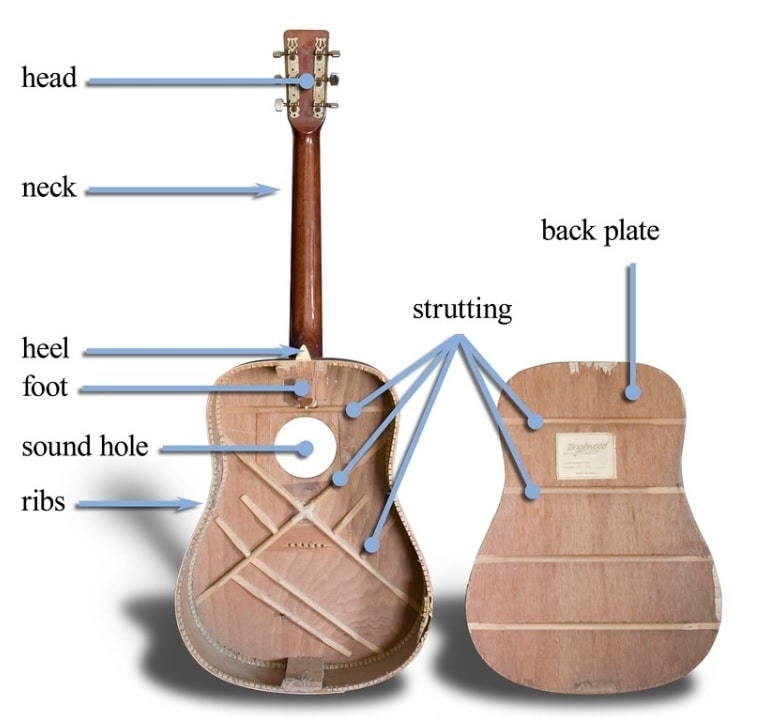
The construction of the guitar is also important. There are three different types: completely solid, solid top, and laminated. These indicate how the wood was used on the guitar. Solid wood means the layer was cut from one slab of wood, whereas laminated wood is made from multiple layers of wood. The difference is pretty much only present in the sound. Solid wood resonates better an usually improves over the years. Laminated wood has a more muted resonance and is stagnant. Because it is treated, laminated wood cannot improve or deteriorate over the years. This also means that maintenance isn’t important. Solid wood can improve over the year, but when improperly maintained, it can also deteriorate. Wood responds to moisture and temperature, but when it’s laminated the pores are blocked. This means that laminated woods are less inclined to respond to humidity and climate changes. Solid wood is more susceptible to change, but this also means it can change for the better. A solid wood acoustic guitar that is used regularly and decently maintained is likely to sound and feel better over time. A more in-depth explanation of guitar maintenance can be found here. However, laminated wood isn’t permanently stagnant. Over a long period of time, usually multiple decades, it is possible for laminated wood to deteriorate. Another aspect to keep in mind is your budget. Laminated wood is usually a bit more affordable than solid wood. This is because solid wood is harder to work with and laminated wood can be made from recycled wood, which is simply cheaper. To be completely forthright, most guitars are a combination of both. Although there are many guitars on the market that are either completely made of solid wood or laminated wood, most guitars have laminated back and sides and a solid wood top. This means most guitars are a compromise between the two, and thus a compromise between the sound and price as well.
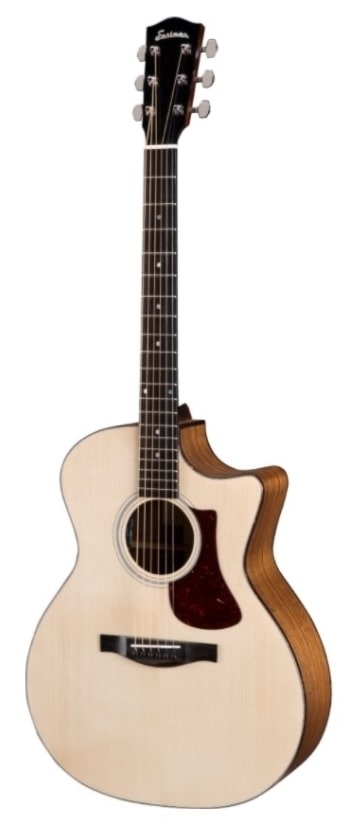
Spruce
Spruce is one of the most popular tonewoods. It is predominantly used for the tops of acoustic guitars. There are two different types of spruce: Engelmann spruce and sitka spruce. Sitka spruce is the most common type and it produces a clear and warm sound. Engelmann spruce comes from North America and is thus more expensive. Engelmann sounds similar, but sounds a little warmer than sitka spruce. Spruce, in general, has a great projection and a decent sustain. Spruce is so popular because it’s really versatile and can be combined with many other kinds of wood. Consequently, there are many guitars with a spruce top and many different backs and sides. This means you can combine the beautiful sound of spruce with your favourite other tonewoods. For example, you can combine it with nato, like the Yamaha CPX700II, or with mahogany, like with the Eastman E6D, as well as many more combinations. Furthermore, spruce is quite sustainable. The trees grow quite fast which makes production quite sustainable and affordable. Spruce also has a recognisable appearance. It has a light colour and a hidden grain, which gives the guitar a neutral and professional appearance.
Mahogany
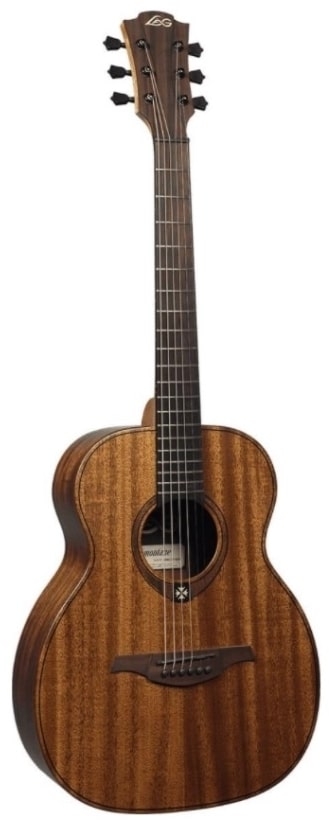
Mahogany is a versatile tonewood that can be used for the top, the back and sides, and the neck of a guitar. Mahogany is mostly used as back and sides because it has a low density and produces a warm and powerful sound. Mahogany also emphasises the mid-tones, which balances the sound out nicely. Mahogany is also known for a ‘woody’ type of sound. This does not mean that the sound is static, but that it has an authentic and typically acoustic sound. Mahogany back and sides are often combined with a spruce top, because the full and authentic sound of the mahogany complements the warmth and sustain of the spruce really well. This is also the case with the Fender CD-60SCE. Some guitars are fully made of mahogany, which means that both the back and sides and the top are mahogany, like the Tanglewood Winterleaf EBK. A guitar completely made of mahogany produces a beautiful and full sound, but is quite rare. Because of the emphasised mid-tones, mahogany is great for guitarists who like fingerpicking. Mahogany is also often used for guitar necks, as is also the case with the Martin D-10E. The wood is soft enough to have great comfortability during playing while creating a stable basis for the neck. Unfortunately, mahogany isn’t very sustainable. Over the last few decades, mahogany has been sourced a lot, for the guitar industry but also for many other industries. Consequently, mahogany has become quite rare. Most of the mahogany trees grow in South America, which makes it very prone to exploitation from the Western market. Recently, mahogany has become a protected wood, to prevent deforestation. Mahogany is still sourced, but it is limited. As a result, mahogany becomes increasingly rarer and more expensive on the market. Certain countries have even implemented restrictions on mahogany. Although mahogany is thus hard to find, there are great alternatives. Real mahogany is often described as ‘Genuine Mahogany’, whereas alternatives are often called ‘True Mahogany’, which can refer to similar woods like khaya or Indian mahogany.
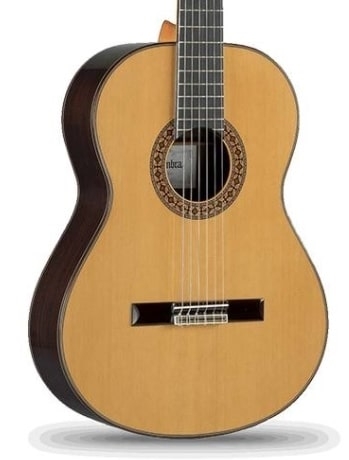
Cedar
Cedar is mostly used as a top for acoustic guitars. It looks similar to spruce, although cedar is slightly darker and has a bit of a reddish tint. However, the sound is completely different. Cedar is softer and warmer than spruce and focuses on the high tones instead of the bass tones. Consequently, cedar is ideal for fingerpicking. Cedar is often used for classical guitars because the nylon strings complement the warm sound beautifully. This is for example the case with the Alhambra 4p. Nevertheless, cedar is also used on western guitars. Cedar sounds a little brighter when combined with steel strings as opposed to nylon strings. A high-quality western guitar with a cedar top is the Art & Lutherie Americana, which has a North-American cedar top and a beautiful and unique look. Although it’s quite rare, cedar is also sometimes used for solid-body electric guitars. This is for example the case with the Michael Kelly Enlightened 55 Dark Tiger’s Eye. Furthermore, cedar is relatively sustainable. Cedar mostly grows in North America and grows quite fast. Additionally, cedar doesn’t waste a lot of water and it’s easy to recycle. This makes cedar a great choice for someone who wants to be a conscious consumer!
Sapele
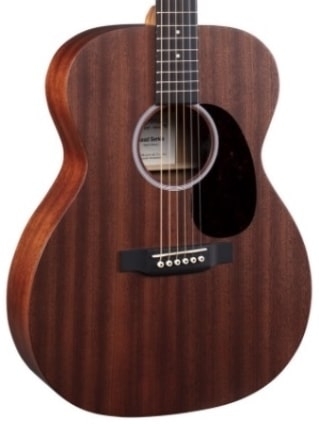
This type of wood is known by multiple names but is mostly called sapele in the guitar industry. Sapele is sourced in Central- and West Africa and has similar characteristics as mahogany. This makes sapele a popular alternative for mahogany. It also sounds quite similar, although sapele sounds a little sharper and brighter than mahogany. It is predominantly used for the back and sides of hollow-body guitars and can be combined with many different tops. For example, it is popular to combine sapele back and sides with a spruce top, like with the Lâg T70DCE. It is also possible to use sapele for the top, but in that case, the back and sides are also made of sapele. This means there are bodies completely made of sapele, which is also the case with the Martin Streetmaster. Complete sapele bodies thus have a clear and balanced sound, although some guitarists find it lacks warmth. Sapele is also more sustainable than mahogany. However, when people figured out it worked as a great alternative for mahogany, sapele also became exploited. This is especially the case in West Africa, where in certain countries the damage hasn’t even yet been restored. This means entire forests were destroyed and the natural ecosystems haven’t recovered either. Nevertheless, certain restrictions and rules have been implemented which means there are specific plantations for the production of sapele, which means sapele can be sourced ethically. Most of it is sourced in Congo, where they have been able to regulate it quite well. Consequently, sapele can be a great and sustainable tonewood and is also a good alternative for mahogany!
Rosewood
Rosewood is a versatile and beautiful tonewood. It has a dark brown colour with a clear and dark grain. Rosewood is mostly used for the back and sides and fretboard of guitars. Rosewood is quite popular for both. As back and sides, rosewood has good resonance and produces a balanced and warm sound, like is also the case with the Eastman E40OM. Rosewood also works great as a fretboard, because it makes the sound slightly warmer and is very comfortable to play. Consequently, there are many guitars with a rosewood fretboard, like the Lâg A200-BRS and the Heritage H-150. There are two types of rosewood: Brazilian rosewood and Indian rosewood. Brazilian rosewood is usually preferred because it produces a bright sound. However, Brazilian Rosewood isn’t really used in the guitar industry anymore. This is because rosewood is over-exploited, just like many other South-American kinds of wood. As 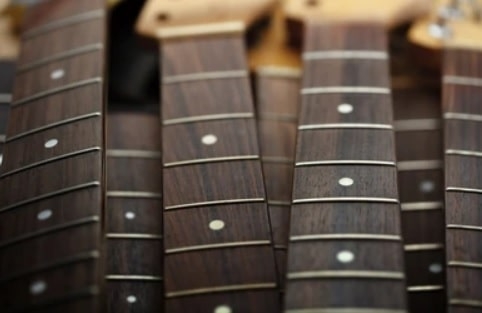 a result, Brazil has implemented an export ban, which is why Indian rosewood is predominantly used nowadays. However, Indian rosewood is also quite exploited, unfortunately. Indian rosewood has a dark purple hue and feels rougher than Brazilian rosewood, but both have similar tone qualities. Rosewood is considered a very authentic tonewood, but due to deforestation, it is unfortunately not sustainable. Rosewood is still used sometimes, but the lumber industry doesn’t prioritise the guitar industry. Most of the rosewood that is available, is bought by the larger guitar companies, which is why rosewood is often only used by certain brands on more expensive guitars. This also means that rosewood isn’t really an option for guitarists with a lower budget, as it is quite expensive. However, there are great alternatives, like pau ferro or ovangkol. A more extensive summary of alternatives can be found at the end of the article!
a result, Brazil has implemented an export ban, which is why Indian rosewood is predominantly used nowadays. However, Indian rosewood is also quite exploited, unfortunately. Indian rosewood has a dark purple hue and feels rougher than Brazilian rosewood, but both have similar tone qualities. Rosewood is considered a very authentic tonewood, but due to deforestation, it is unfortunately not sustainable. Rosewood is still used sometimes, but the lumber industry doesn’t prioritise the guitar industry. Most of the rosewood that is available, is bought by the larger guitar companies, which is why rosewood is often only used by certain brands on more expensive guitars. This also means that rosewood isn’t really an option for guitarists with a lower budget, as it is quite expensive. However, there are great alternatives, like pau ferro or ovangkol. A more extensive summary of alternatives can be found at the end of the article!
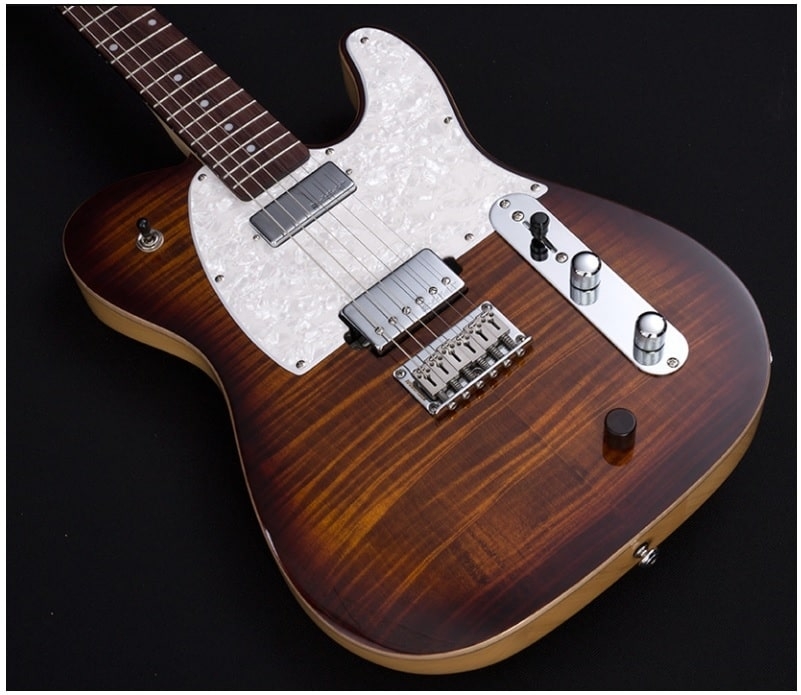
Maple
Maple is also very popular as a fretboard, neck, top, and back and sides. Maple grows predominantly in the northern hemisphere and most of it is sourced from Asia. Maple has a light colour, which could look nearly white, and has a unique grain pattern. For example, this is illustrated with the maple top of the Michael Kelly Hybrid 55 on the photo. This guitar does contain a wood stain, which changes the colour of the wood but still shows the natural grain. Because this natural pattern is very beautiful, maple tops are often used on electric guitars. Maple necks and fretboards often look more monotone and don’t have that clear grain pattern. The light colour of the wood makes it easy to combine with many other kinds of wood as well. Maple is very popular for fretboards because it is very comfortable to use and articulated the sound beautifully. Popular guitars with maple fretboards are the Aria Pro II 714-MK2 and the Fender Vintera ‘50s Telecaster. Maple fretboards sometimes contain a finish, as one of the only fretboard woods. This means that lacquered maple fretboards don’t need to be regularly maintained like an unfinished fretboard. Maple fretboards are also usually combined with a maple neck because maple has a high density which makes it a stable basis. When used as a hollow body, maple produces a bright and clear sound. It is predominantly used as back and sides, but it is also sometimes used as a top. Additionally, maple is quite sustainable. It’s the most common tree in North America and it grows really fast, which means it can be sourced without damaging the forests or the biodiversity of these areas. Maple also produces little CO₂ when it is cultivated, which makes maple an environmentally friendly tonewood with a powerful and bright sound!
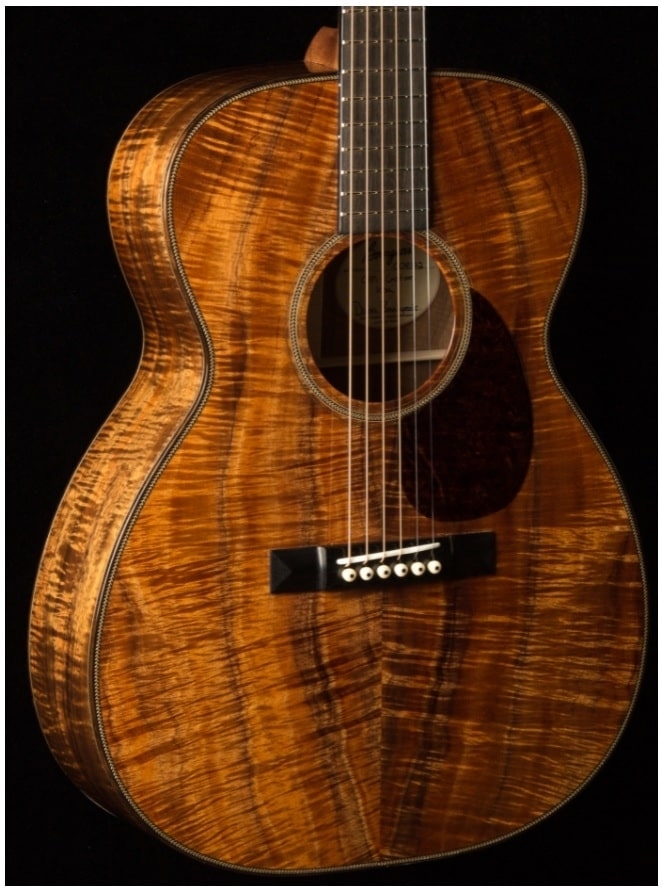
Koa
Koa is a Hawaiian tonewood. Koa only grows in Hawaii and was historically used for the production of canoes. In 1879 Portuguese immigrants brought the ukulele to Hawaii, where the Hawaiians themselves started making these instruments with koa. This is where the incredible tone qualities of koa were discovered. Nowadays koa is also used for acoustic guitars, such as the Tanglewood Winterleaf Exotic, but it’s also still used for ukuleles, like with the Martin C1K. Koa produces a bright but warm sound and it has great resonance. Additionally, koa improves over the years. This means that when the instrument is purchased it already sounds beautiful, but koa opens up even more when the instrument is played regularly. After a while, koa will sound even richer and warmer. Furthermore, koa is also insanely pretty. It has a medium brown colour with a unique grain pattern. The grain isn’t always straight, which means koa can contain lots of different patterns and shapes. Unfortunately, koa instruments are relatively rare and quite expensive. This is because Hawaii has implemented trade restrictions to help restore the forests. This is necessary because over the past century 90% of the forests were cut down. However, koa does grow quite fast, which means koa is still produced for the lumber trade. This is done under supervision and produces a limited amount of koa. This means most koa instruments are limited edition. It is thus still possible to purchase a koa guitar!
Ebony
Ebony is mostly used as a fretboard, but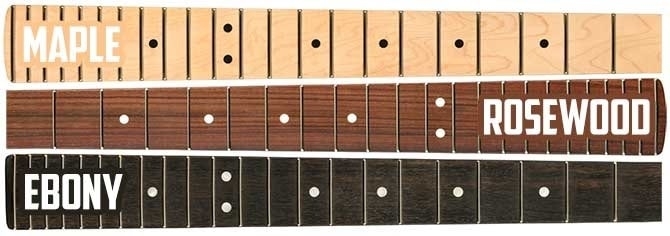 it can also be used for hollow-body guitars. An ebony fretboard will balance out the sound beautifully, which makes it a popular choice. Great guitars with ebony fretboards are the Yamaha SA2200 and the Eastman Romeo LA. As back and sides, ebony emphasises the bass tones and has a great sustain. Some people find that ebony sounds too bright and it’s also quite heavy. Subsequently, it’s not used for hollow-body guitars all that often. However, ebony is very popular for fretboards and for solid body tops. Ebony tends to have beautiful patterns, which means it’s often seen on professional electric guitars, such as the Michael Kelly 1965 Ebony Custom. Unfortunately, ebony isn’t very sustainable. It is predominantly sourced from West- and South Africa and has been subjected to deforestation for decades. At the moment, ebony is officially recognised as an endangered wood. Many countries have subsequently implemented restrictions on ebony, which makes it a rare and expensive material. It’s also crucial that these forests are restored, as ebony is crucial to the biodiversity of these regions. Ebony is still available, though, as it’s not restricted in Cameroon. Certain companies source their ebony from sustainable plantations, but there are also companies that still participate in deforestation. This makes it hard to establish whether ebony guitars can be a sustainable purchase. There are some companies that have completely stopped using ebony altogether. A great synthetic alternative has even been produced: Richlite.
it can also be used for hollow-body guitars. An ebony fretboard will balance out the sound beautifully, which makes it a popular choice. Great guitars with ebony fretboards are the Yamaha SA2200 and the Eastman Romeo LA. As back and sides, ebony emphasises the bass tones and has a great sustain. Some people find that ebony sounds too bright and it’s also quite heavy. Subsequently, it’s not used for hollow-body guitars all that often. However, ebony is very popular for fretboards and for solid body tops. Ebony tends to have beautiful patterns, which means it’s often seen on professional electric guitars, such as the Michael Kelly 1965 Ebony Custom. Unfortunately, ebony isn’t very sustainable. It is predominantly sourced from West- and South Africa and has been subjected to deforestation for decades. At the moment, ebony is officially recognised as an endangered wood. Many countries have subsequently implemented restrictions on ebony, which makes it a rare and expensive material. It’s also crucial that these forests are restored, as ebony is crucial to the biodiversity of these regions. Ebony is still available, though, as it’s not restricted in Cameroon. Certain companies source their ebony from sustainable plantations, but there are also companies that still participate in deforestation. This makes it hard to establish whether ebony guitars can be a sustainable purchase. There are some companies that have completely stopped using ebony altogether. A great synthetic alternative has even been produced: Richlite.
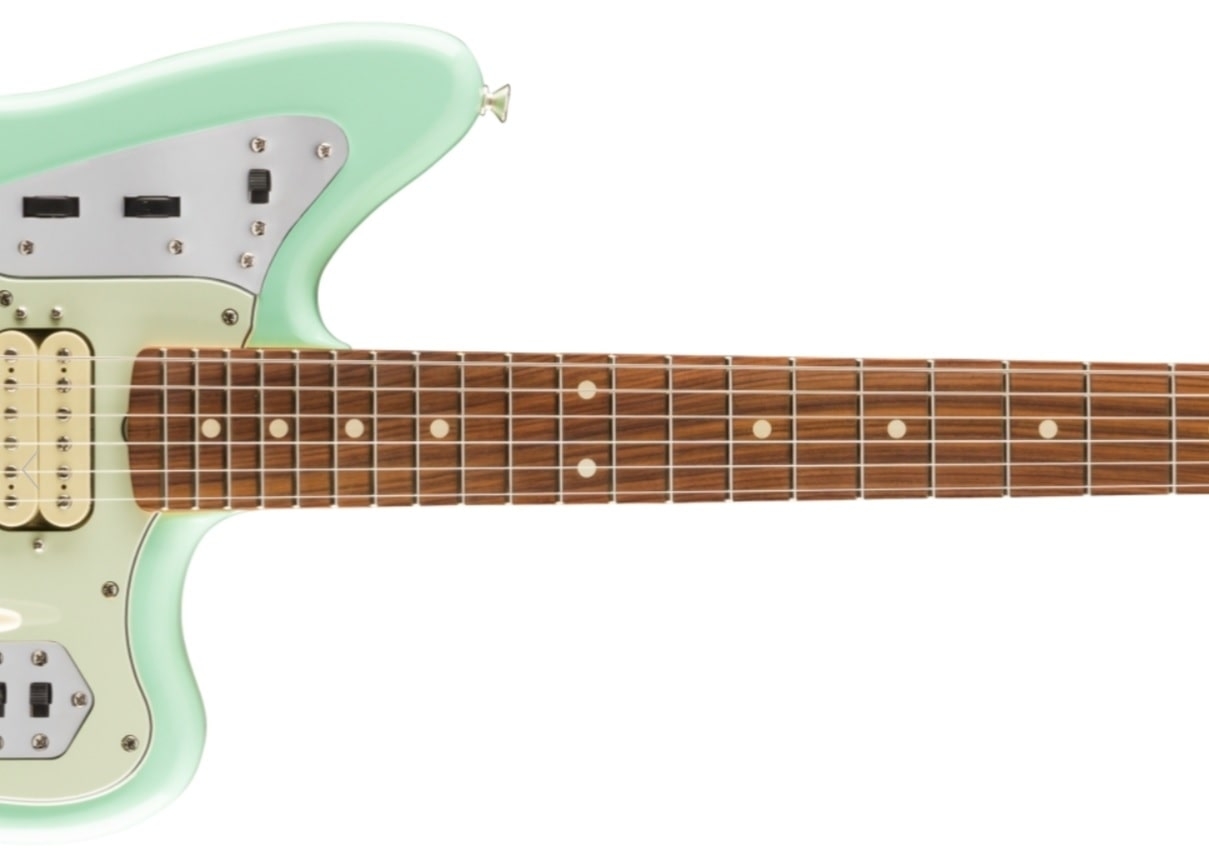
Pau ferro
Pau ferro is a great tonewood for the fretboard. It’s also considered a more sustainable and cheaper alternative to rosewood. Pau ferro is sourced from South America and it has a warm and articulated sound. The sound and feel are similar to rosewood, although its colour is slightly lighter. It also feels similar to ebony, which means it’s also a great alternative for guitarists who like the comfort of ebony. However, ebony sounds a lot brighter than pau ferro, whereas pau ferro sounds a lot warmer. It is also quite sustainable. At this moment, it is not endangered and there is no threat of future endangerment. This makes pau ferro both sustainable and affordable. There are many companies that are slowly replacing their rosewood fretboards for pau ferro fretboards, including Fender and Michael Kelly. High-quality guitars with pau ferro fretboards include the Fender Noventa Jazzmaster and the Michael Kelly Patriot Instinct Bold.
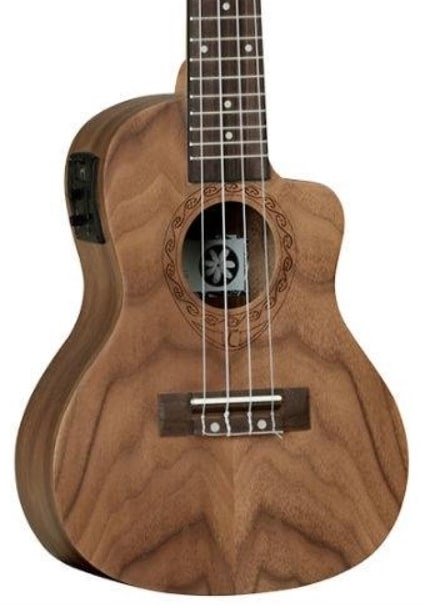
Walnut
Walnut is a great tonewood which is similar to koa in regards to density and brightness, although walnut sounds a little deeper and more authentic. Walnut can be used for the top and back and sides, but it’s predominantly used for the back and sides. It’s also a very popular tonewood for ukuleles and fretboards. There are many great walnut ukuleles, like the Kala KA-PWC or the Tanglewood TWT13E. Walnut can also be used for a fretboard, like with the Artesano Estudiante XA-4/4. It’s a little softer than most woods used for fretboards, but walnut can be strengthened with lacquer and maintenance. Furthermore, walnut is also sustainable. It’s mostly sourced from North America and there is still an abundance of walnut trees. This also makes it quite affordable. Additionally, walnut is also a beautiful tonewood, as it has a dark brown colour with an even darker grain. Walnut can also have beautiful grain patterns, which gives your instrument a beautiful and unique appearance.
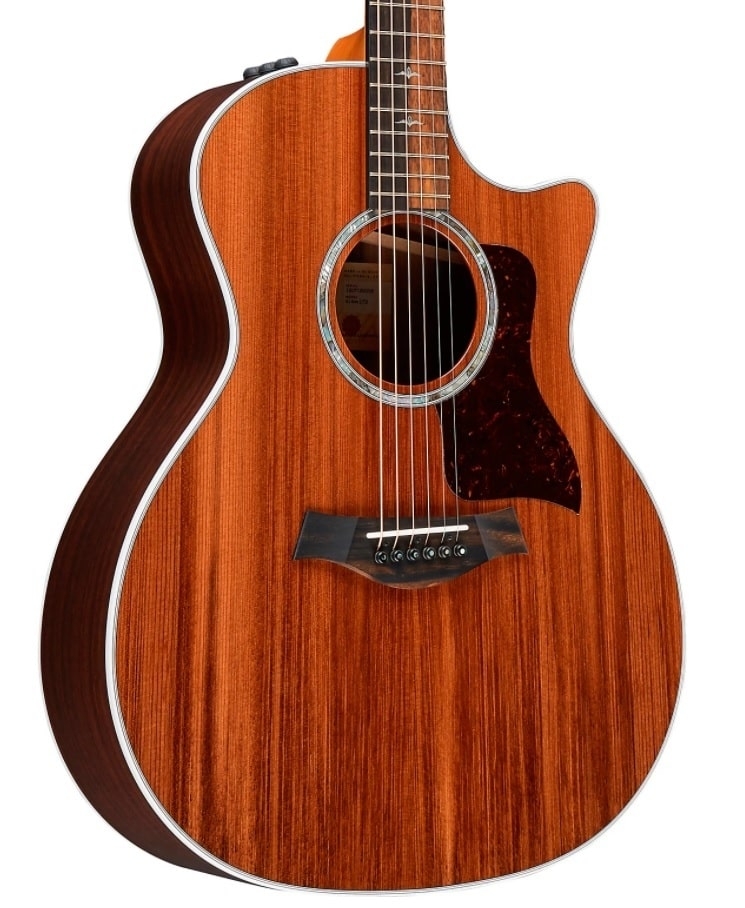
Sequoioideae/Redwood
Redwood, which is officially called sequoioideae, is a great and beautiful tonewood. Redwood sounds a little similar to cedar, because both have a warm sound, although redwood sounds a little brighter and fuller. Redwood is often combined with mahogany, rosewood, or macassar. It can be used as a top, back and sides, but can also be used as a top for electric guitars because of the beautiful colour of the wood. Redwood only grows in central China, California, and Oregon, which means it’s actually quite rare. However, the trees tend to be quite large, which means production is still quite sustainable. Unfortunately, redwood is endangered due to deforestation, wildfires, and climate change. Nevertheless, most redwood guitars are made from old trees that fall over themselves. Some trees are even fished up from rivers for lumber production. This doesn’t only mean that redwood guitars can be really sustainable, but trees that are centuries old often have beautiful colours and patterns. This is especially the case with trees from rivers because the salt and minerals change the colours of the wood.
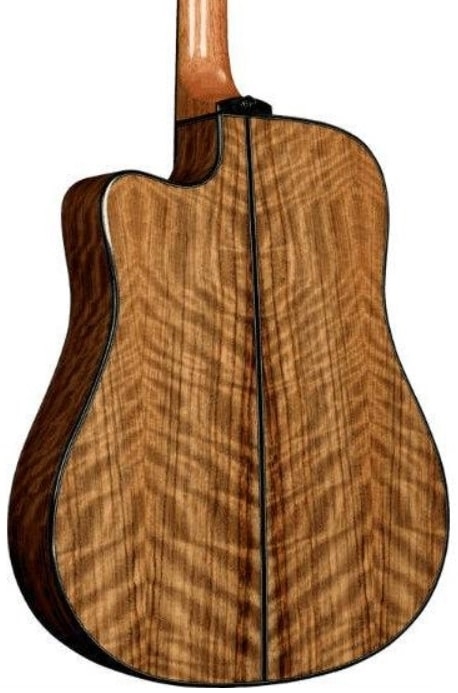
Ovangkol
Ovangkol is relatively similar to rosewood. It comes from Central and West-Afrika and is a sustainable alternative. Ovangkol produces a warm and balanced sound. It sounds a little fuller and brighter than rosewood, but it’s still a popular alternative. Some guitarists even prefer ovangkol, because it’s also very versatile and can be combined with many other tonewoods. It’s mostly used as back and sides, both of western guitars and classical guitars, like the Eastman AC222CE and the Lâg HyVibe 20. Ovangkol has a medium brown colour with a straight and dark grain pattern. Subsequently, ovangkol is also popular because of its beautiful appearance. It’s also more sustainable than rosewood, although due to the irregular growth pattern there is a possibility of habitat loss. This isn’t necessarily the result of deforestation and ovangkol isn’t officially endangered. This means that ovangkol can be a sustainable material.
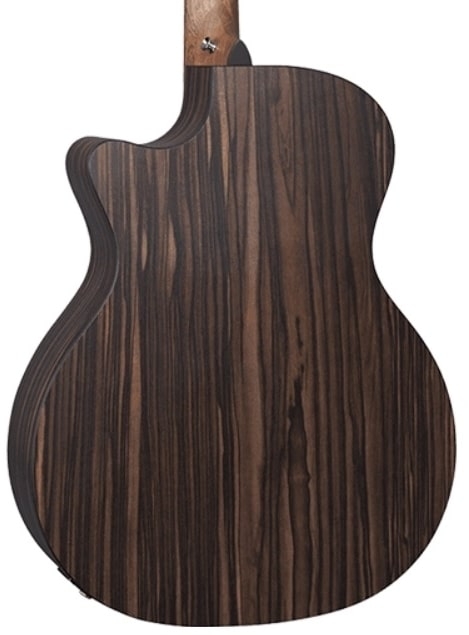
Macassar
Macassar is predominantly used as an alternative for ebony. Macassar is technically part of the ebony species. It only grows on Sulawesi, in Indonesia. It has a high density, which makes it perfect for fretboards and back and sides. It has a similarly dark colour to ebony. Macassar has a dynamic response with an emphasised bass and great projection. This beautiful projection makes it a popular tonewood for back and sides, such as with the Martin GPC-X2E. Macassar also opens up over time, which means it’ll sound better when it’s regularly played. Unfortunately, macassar also becomes increasingly more endangered. It’s even classified as ‘vulnerable’ by the IUCN, which means it’s not a sustainable tonewood.
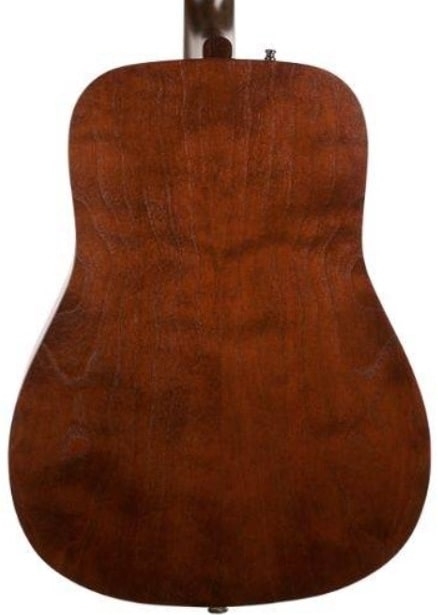
Cherry
Cherry, sometimes also called wild cherry, is a North-American tonewood. Cherry grows in abundance, which means it’s quite affordable and sustainable. Cherry is mostly used for the back and sides because it has beautiful sustain and a warm sound. Cherry produces nicely articulated tones, but it isn’t loud. Furthermore, it also looks beautiful. It has a brown colour with a reddish tint and a stunning grain. This is illustrated with the Art & Lutherie Americana, whose back and sides are made of cherry. The wood has been stained, which means it’s slightly darker than regular cherry would be, but the natural grain is still visible. Art & Lutherie often uses Canadian wild cherry for their guitars, because it’s sustainable and produces a beautiful and unique guitar like they also did with the Legacy Q-Discrete. The IUCN has classified cherry as ‘least concern', which thus makes this guitar ideal for the environmentally conscious guitarist.
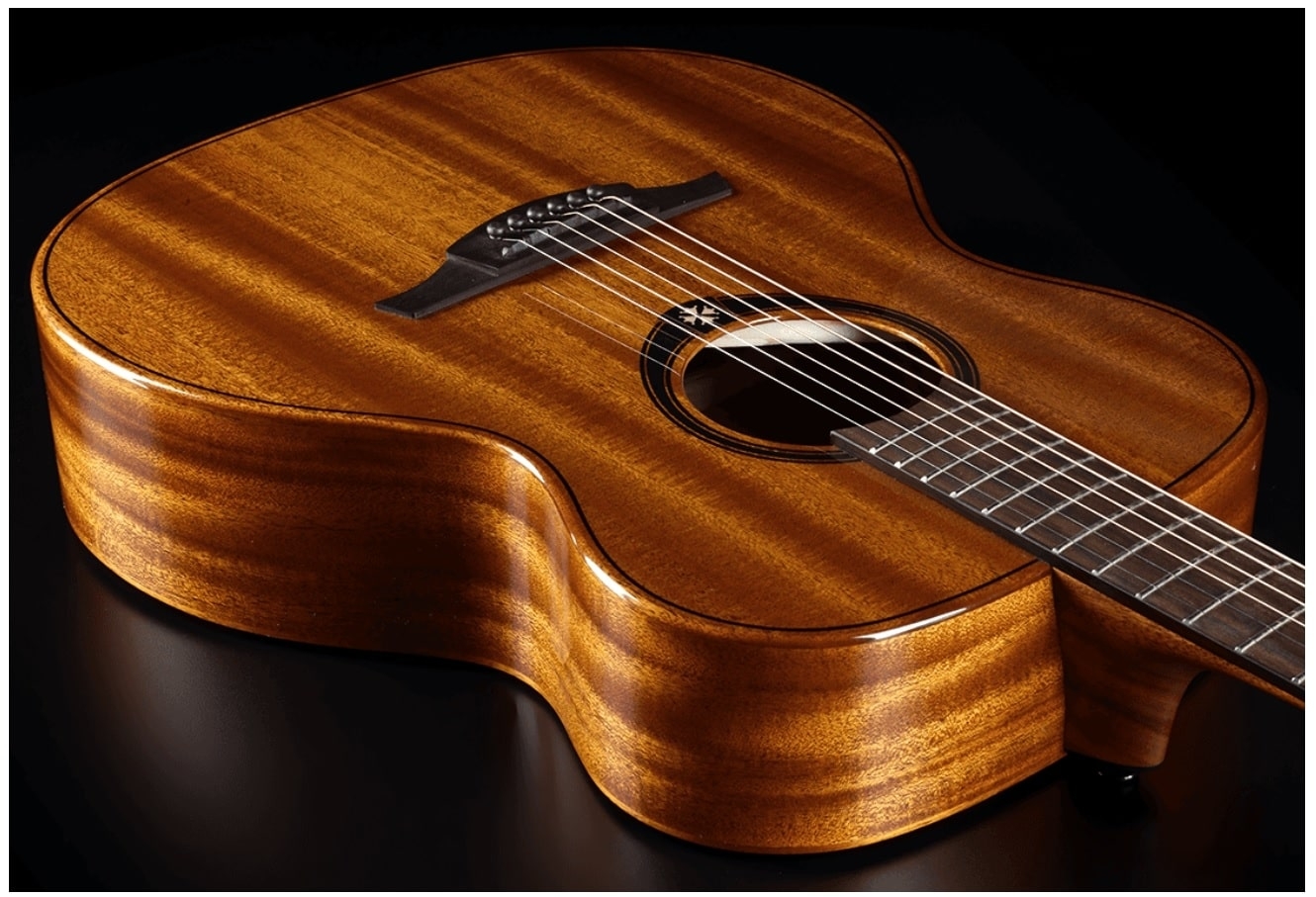
Khaya
Khaya is a popular alternative for mahogany, it’s also often referred to as ‘African mahogany’. Khaya is part of the same species as mahogany and has a similarly warm and balanced sound. However, khaya also sounds a little brighter and has a beautiful authentic sound. It can be used for the back and sides, top, and neck. Lâg often uses khaya for their guitars, like with the T90E Parlor and the T98A Auditorium, which are the perfect guitars for the musician who loves unique guitars. Aesthetically, khaya is also similar to mahogany. It has a dark brown colour and a straight grain. Khaya trees are relatively common in Central and West Africa, which means it’s relatively sustainable and affordable. The trees also grow relatively fast, which means the growth can keep up with lumber production.
Alder
Alder is a common tonewood that grows in many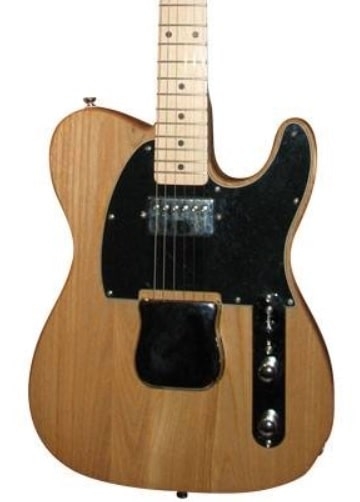 different climates. It has little resonance, which means it’s not ideal for hollow bodies. This means it’s mostly used for solid-body electric guitars. Alder is also ideal for necks because it’s very rigid and lightweight. Subsequently, the neck will be able to endure frequent and intensive use. However, it’s mostly used as a solid body, as it makes a sturdy guitar that isn’t all that heavy. Alder also has great sustain and emphasises the bass tones. Fender often uses alder for their guitars, which means alder is common for both their affordable and more expensive guitars. For example, the Fender Player Mustang ’90 and the Squier Affinity Telecaster are made of alder, but also their more expensive Fender Player Plus Nashville Telecaster and the Fender 75th Anniversary Stratocaster. Furthermore, alder has a light colour which makes it an ideal base for many different lacquers. This means you can find alder guitars with many different bright colours or even more muted colours. However, alder can be used with clear lacquer as well. This is the case with the Otentic T Custom, which is also the guitar in the attached photo. The T Custom is a custom guitar from the local brand Otentic, which is located in Gorinchem. This guitar only has a sheer clear finish for protection, but it doesn’t change the colour of the guitar. Alder is also quite sustainable. Alder grows in many places and it grows quite fast, which means the growth can keep up with the cultivation.
different climates. It has little resonance, which means it’s not ideal for hollow bodies. This means it’s mostly used for solid-body electric guitars. Alder is also ideal for necks because it’s very rigid and lightweight. Subsequently, the neck will be able to endure frequent and intensive use. However, it’s mostly used as a solid body, as it makes a sturdy guitar that isn’t all that heavy. Alder also has great sustain and emphasises the bass tones. Fender often uses alder for their guitars, which means alder is common for both their affordable and more expensive guitars. For example, the Fender Player Mustang ’90 and the Squier Affinity Telecaster are made of alder, but also their more expensive Fender Player Plus Nashville Telecaster and the Fender 75th Anniversary Stratocaster. Furthermore, alder has a light colour which makes it an ideal base for many different lacquers. This means you can find alder guitars with many different bright colours or even more muted colours. However, alder can be used with clear lacquer as well. This is the case with the Otentic T Custom, which is also the guitar in the attached photo. The T Custom is a custom guitar from the local brand Otentic, which is located in Gorinchem. This guitar only has a sheer clear finish for protection, but it doesn’t change the colour of the guitar. Alder is also quite sustainable. Alder grows in many places and it grows quite fast, which means the growth can keep up with the cultivation.
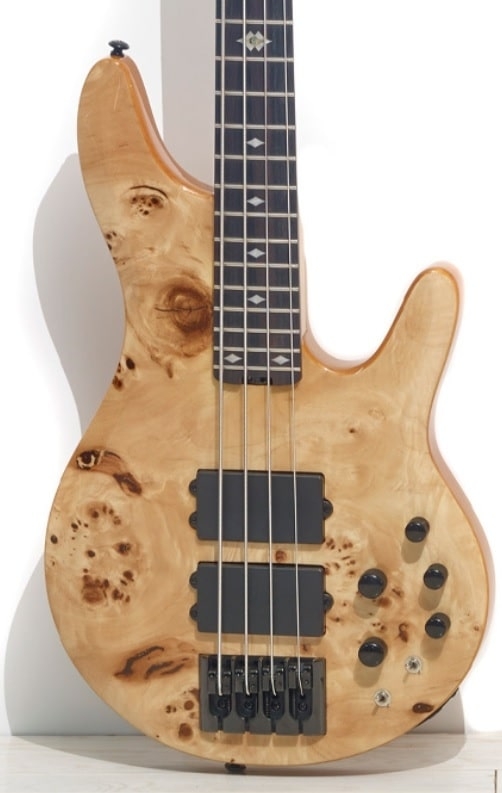
Poplar
Poplar is a softwood, which doesn’t make it suitable for guitar necks or fretboards. Poplar also doesn’t resonate well, which means it cannot be used for hollow bodies either. Nevertheless, poplar is perfect for solid-body electric guitars and basses, like the Ibanez GRG140-WH and the Squier Affinity Stratocaster HH. Poplar is very lightweight and produces a balanced sound. The wood is soft but rigid enough for it to be a strong solid-body guitar. However, hardwood, like pine or mahogany, might be a better option for the guitarists who play quite roughly. Fortunately, poplar is strong enough for most guitarists, as poplar needs to be bumped really hard for it to be dented. Poplar isn’t that pretty, either. It has a light colour with a green tint. Fortunately, poplar is very easy to paint, as it has a light grain and a smooth texture. This means poplar guitars often have beautiful brightly painted colours. There is an exception to this, though; poplar is one of the few trees that can develop a burl pattern. These patterns are very beautiful and unique, which means burled poplar is often used as a top for solid body guitars, as is visible on the beautiful Michael Kelly bass in the photo. Furthermore, poplar is quite sustainable. Poplar grows in many places in the northern hemisphere and it grows extremely fast. This means there are many poplar forests and the cultivation can be easily corrected. Poplar also filters a lot of CO₂, aren’t dependent on the climate, and filter the groundwater. Poplar is thus an environmentally friendly and affordable tonewood.
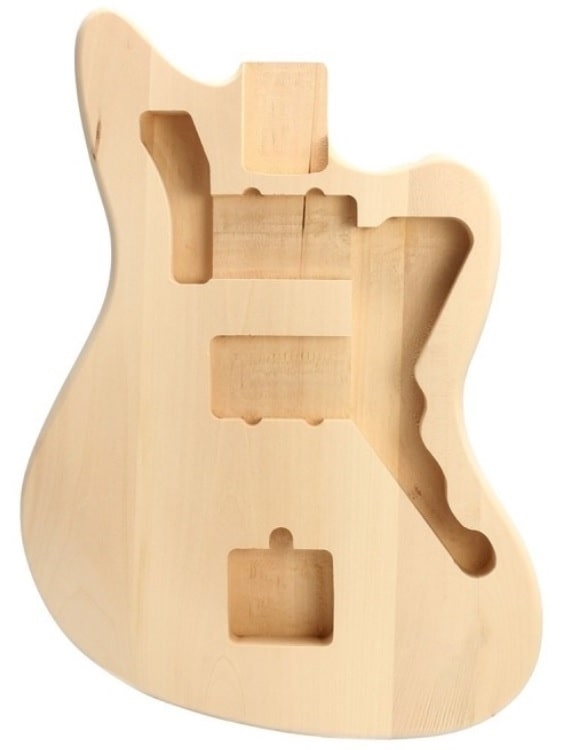
Basswood
Basswood is a softwood, even softer than poplar. Because of this, basswood isn’t used for fretboards or necks but is quite common for solid-body electric guitars. Basswood isn’t recommended for careless musicians, as basswood dents quite easily. However, it’s really lightweight and has great sustain. The colour of basswood is also quite light and the grain is nearly invisible. Subsequently, basswood is usually painted. In the picture, you’ll see what a basswood body looks like without any lacquer. Popular guitars with basswood bodies are among others the Godin Stadium HT, the Aria Pro II 615-Frontier, and the Lâg I100-OPS. Basswood can also be used for hollow-body guitars. As basswood is quite soft, it is usually laminated, as with the Stagg SA20D. This will produce a muted and balanced sound. Basswood is often used for more affordable acoustic guitars because it produces a neutral sound and the wood itself is quite affordable. Moreover, it’s also quite sustainable. According to the IUCN, basswood is classified as ‘least concern. It’s a common tree in North America and it grows quite fast.
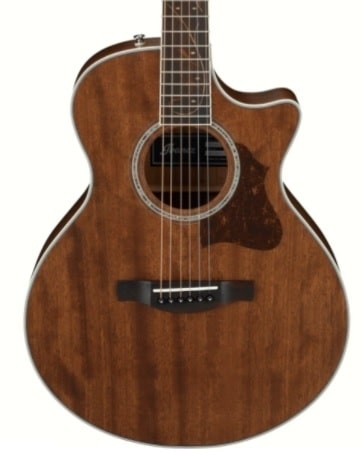
Okoume
Okoume is mostly used for the back and sides, necks, and tops. It isn’t very rigid, but an experienced luthier can make a decent guitar out of it. Okoume also has great resonance and produces a clear and bright sound. It is most prominent for the back and sides, such as with the Yamaha FG800 and the Ibanez AVD11CE. Okoume is a good alternative for maple and mahogany when it comes to sound. Okoume can also be used for solid-body electric guitars, like with the Ibanez GSA60-WNF and the Ibanez GRG140-SB. Okoume has a beautiful colour with unique grain, and it is a little lighter than mahogany. Unfortunately, okoume isn’t very sustainable. It’s been classified by the IUCN as ‘vulnerable’, which means it’s one classification away from ‘threatened’. This is because it only grows in Gabon, Congo, and Mbini, and it’s predominantly sourced from Gabon. Increasingly more forests are managed by the FSC, which means okoume is slowly becoming more sustainable.
Pine
Pine is a relatively rare but decent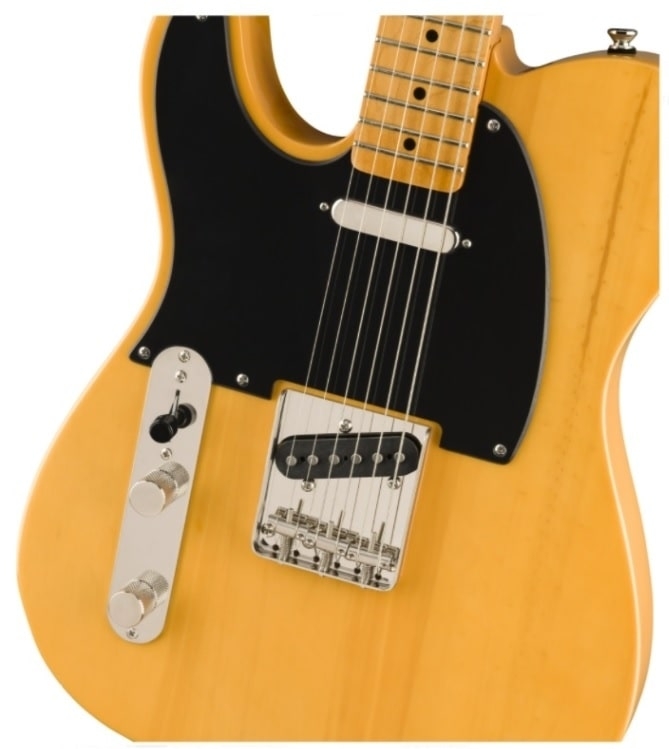 tonewood. It isn’t rare like mahogany, which is rare due to deforestation, but rare because it simply isn’t used that often. It’s most often used as a solid body, as it gives the guitar a comfortable weight and makes the sound a little warmer and brighter. Pine also provides great projection. Furthermore, pine is very sustainable. It grows almost everywhere in the northern hemisphere and all the commercial pine is grown on plantations. Although it’s quite rare in the guitar industry, pine is used for many other products and has to be produced as efficiently as possible. Pine trees also grow very fast and produce little CO₂ when cultivated. But why is pine not often used in the guitar industry? It has nothing to do with sound, as pine sounds beautiful, but it can be hard to work with. It’s not easy to manipulate into different shapes and it has a distinct grain that needs to be meticulously sanded down before it can be painted. Most companies prioritise efficiency, and they can’t produce as many guitars at the same time as, for example, with alder or poplar. However, this doesn’t mean pine guitars are always expensive. Although pine requires more time to cultivate, which means it requires more wages, but as a material pine is very cheap. This means larger companies usually produce pine guitars as limited editions, whereas some smaller companies do offer pine guitars as regular guitars. Squier is an exception to this rule. Within their Classic Vibe series they offer pine guitars. This is because Fender’s first Telecaster was made of pine, so Squier offers these vintage-inspired guitars in pine, such as the Squier Classic Vibe ‘50s Butterscotch Blonde, which is also visible on the picture on the side. With this model, the pine is visible through the lacquer, as they used a clear lacquer, but they also offer their pine guitars with bright colours, such as the Squier Classic Vibe ‘50s Stratocaster in red.
tonewood. It isn’t rare like mahogany, which is rare due to deforestation, but rare because it simply isn’t used that often. It’s most often used as a solid body, as it gives the guitar a comfortable weight and makes the sound a little warmer and brighter. Pine also provides great projection. Furthermore, pine is very sustainable. It grows almost everywhere in the northern hemisphere and all the commercial pine is grown on plantations. Although it’s quite rare in the guitar industry, pine is used for many other products and has to be produced as efficiently as possible. Pine trees also grow very fast and produce little CO₂ when cultivated. But why is pine not often used in the guitar industry? It has nothing to do with sound, as pine sounds beautiful, but it can be hard to work with. It’s not easy to manipulate into different shapes and it has a distinct grain that needs to be meticulously sanded down before it can be painted. Most companies prioritise efficiency, and they can’t produce as many guitars at the same time as, for example, with alder or poplar. However, this doesn’t mean pine guitars are always expensive. Although pine requires more time to cultivate, which means it requires more wages, but as a material pine is very cheap. This means larger companies usually produce pine guitars as limited editions, whereas some smaller companies do offer pine guitars as regular guitars. Squier is an exception to this rule. Within their Classic Vibe series they offer pine guitars. This is because Fender’s first Telecaster was made of pine, so Squier offers these vintage-inspired guitars in pine, such as the Squier Classic Vibe ‘50s Butterscotch Blonde, which is also visible on the picture on the side. With this model, the pine is visible through the lacquer, as they used a clear lacquer, but they also offer their pine guitars with bright colours, such as the Squier Classic Vibe ‘50s Stratocaster in red.
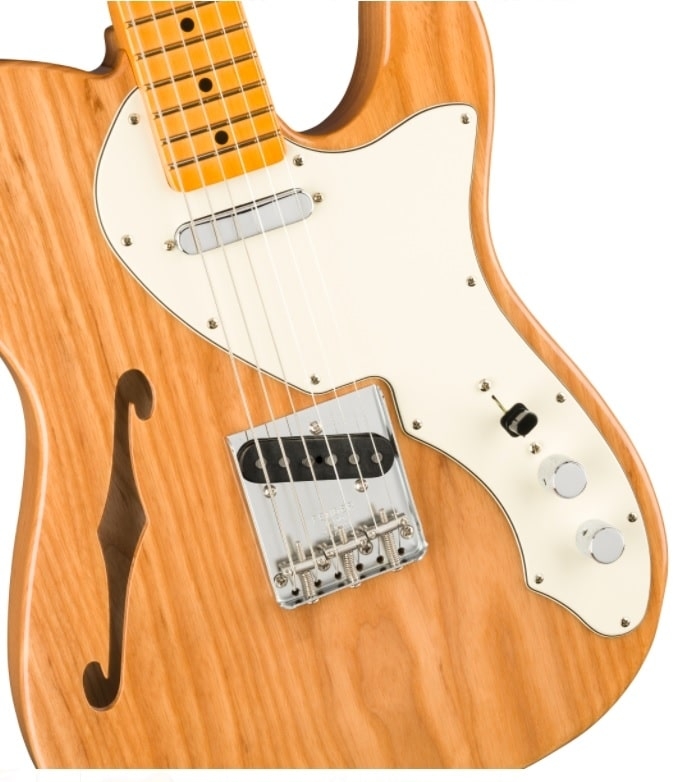
Ash
Ash is mostly used for electric guitars, like with the Michael Kelly 1965 Ebony Custom Collection, which has an ash body and an ebony top, or with the Michael Kelly Mod Shop 1967 Double Duncan. Ash is relatively rigid, which makes ash guitars quite sturdy. Hardware will stay nicely in place and it won’t dent easily. Moreover, ash produces a bright and balanced sound with an emphasis on the bass. It’s a little heavier than alder or poplar, but not as heavy as mahogany. The consensus is that ash sounds best with single-coil pickups, so it doesn’t come as a surprise that Fender likes to use ash for their guitars. Fender mostly used ash for their Telecasters and Stratocasters, but since 2020 they have slowed down their use of ash. This is because the emerald ash borer is now present in North America. This is an invasive beetle species that is incredibly destructive and detrimental to ash forests. They eat the bark of ash trees, which kills the trees. The beetles also reproduce incredibly quickly which means they cannot be contained and they destroy entire forests in very little time. Subsequently, Fender has decided to stop producing ash guitars as they are afraid ash might be extinct in a couple of years. This means they only use ash for very specific signature and high-end models. Ash is technically quite sustainable: it grows fast and isn’t subjected to deforestation or climate change, but unfortunately, it is near-extinct due to natural circumstances. In North America, it's threatened due to the beetle, and in Europe, it’s being destroyed by the fungus hymenoscyphus fraxineus. It’s also expected that the beetle will soon be introduced in Europe as well. The European Union has classified ash under their fifth sustainability classification, which means they expect ash to go extinct within five years. In Asia, ash still grows relatively well. This is because the emerald ash borer is native to Asia, which means the trees are used to it. However, they are not immune to the fungus, which is also common in Asia, although it’s not as prevalent as in Europe. Furthermore, Asian ash isn’t often used for guitars as it has different characteristics than American ash. Ash that’s cultivated for lumber trade tends to be decently sustainable, as it’s harvested from plantations where they can control the environment. Ash guitars are amazing, they sound fantastic and are comfortable. Unfortunately, ash will likely be extinct soon which means the stock of ash guitars isn’t infinite.
Indian Laurel (Terminalia Elliptica)
-min.jpg)
This tonewood has many different names, but is mostly known as Indian laurel in the guitar industry. It is sourced from Southeast Asia and it’s very common. When rosewood became scarce, it was introduced as a great alternative for fretboards. Laurel is quite rigid and smooth, which makes it ideal for fretboards. The comfortability is similar to rosewood and laurel balances the tones out nicely. It can also have different colours; some pieces can be as dark as rosewood, whereas others may be closer to pau ferro. Laurel is used as a fretboard for both acoustic and electric guitars. Furthermore, laurel is quite sustainable. It isn’t listed by CITES and the IUCN has not classified it as vulnerable or threatened. Subsequently, Indian laurel is a sustainable alternative for rosewood and ebony. Squier has been making great strides in this, as they have switched their production to laurel. They now produce the majority of their guitars with laurel fretboards as opposed to rosewood, like with the Squier Classic Vibe ‘60s Jazzmaster and the Squier Affinity Telecaster Deluxe. There are also other brands that produce guitars with laurel fretboards, like the Godin Session HT.
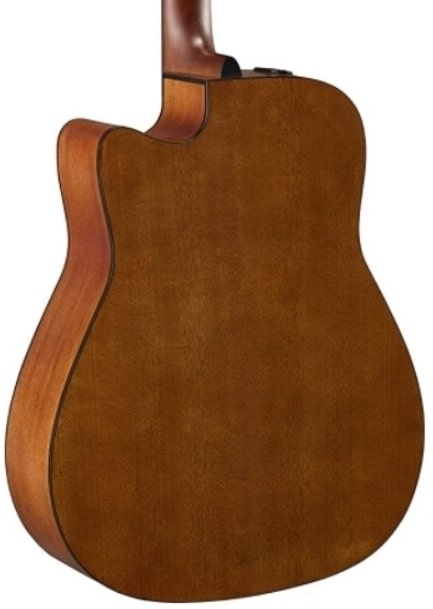
Nato
Nato, which is also known as mora, is a great tonewood for necks, back and sides, and solid bodies. It’s also important to note that nato isn’t the same as nyatoh. They are different tonewoods that look similar but sound different. Nato originates from South and Central America and sounds similar to mahogany, although a little brighter. Consequently, nato is ideal for the back and sides, as with the Yamaha APX700II. Additionally, nato is very sturdy and relatively affordable. Its rigidity also makes it suitable for guitar necks. The Fender FA-235E and the Ibanez V54NJP are popular guitars with nato necks. Nato has a beautiful medium brown colour with a red undertone, which means it can both be painted over or finished with a clear lacquer. Nato is still a relatively new material in the guitar industry, but it’s becoming increasingly more common. This is mostly because other popular tonewoods are becoming rare, and nato is a great alternative and is also sustainable. It is not listed by CITES or the IUCN, and the mora tree is common and can grow really big which means they can sustain the lumber production.
Nyatoh
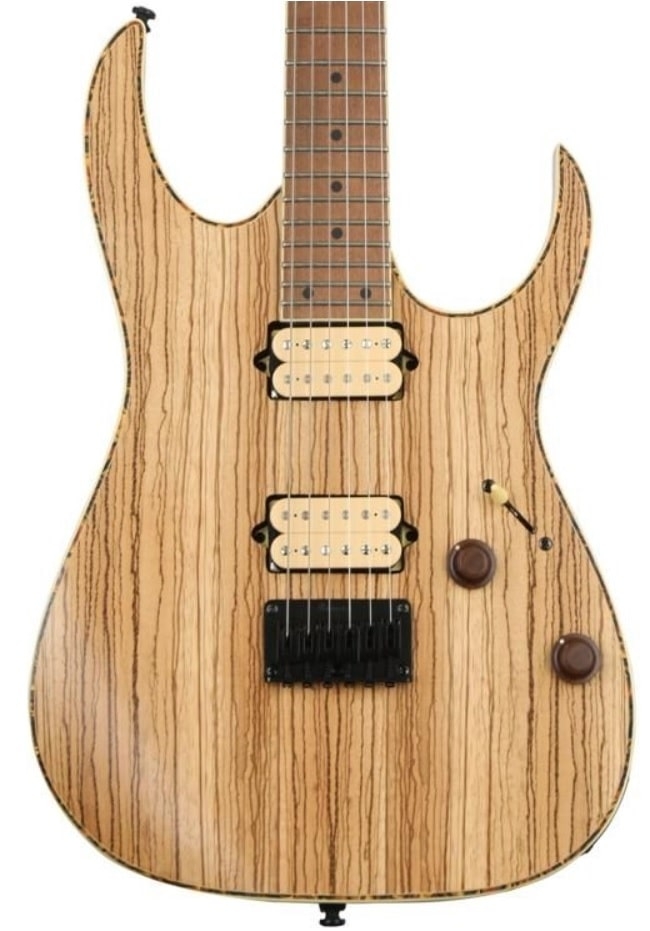
Nyatoh is increasingly getting more popular in the guitar industry. However, it’s technically not a single tonewood. Nyatoh is an umbrella term that includes species from the palaquium and payena genera. This means nyatoh can be made from hundreds of different types of trees, all of which are located in rainforests in Southeast Asia. Fortunately, all these wood types are similar to each other. Nyatoh is known for its dark colour with either a red or purple undertone. Nyatoh is often confused with nato, which is also a common tonewood. However, both are very different, as nato originates from South America and nyatoh from Southeast Asia. Nyatoh is also a little softer, which means it’s often used for solid body guitars and basses, like with the Ibanez SR300EB and the Ibanez GSR200B. Nyatoh is a popular alternative for unsustainable tonewoods, which have been subjected to deforestation. It’s relatively similar to poplar, and it also could be a good alternative for ash. Nyatoh is a little more sustainable, although it depends on the supplier. A few species under the umbrella term have been classified by the IUCN as ‘vulnerable’, as a result of exploitation. Nevertheless, nyatoh can be sustainable, as long as the producer sources their wood from reliable suppliers.
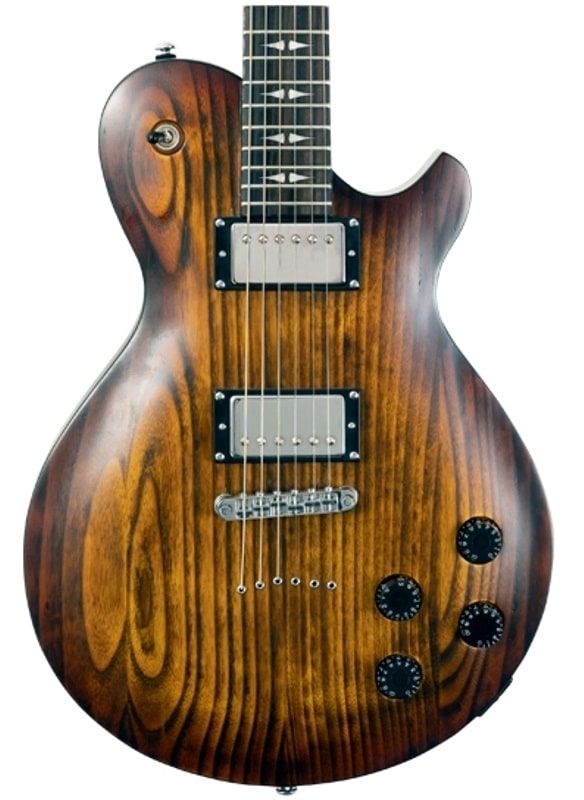
Sungkai
Sungkai has only recently been discovered as a tonewood. Michael Kelly, who are known for their innovativity, is one of the biggest companies that uses sungkai on a large scale. They mostly use it for solid body guitars, like the Michael Kelly 1963 Open Pore and the Michael Kelly 1954 Open Pore. Sungkai solely grows in Indonesia, Thailand, and Malaysia. It’s also known as Indonesian ash, as it has similar tonal qualities and a similar appearance to ash. Sungkai is relatively light but sturdy enough to be used intensively. This also means that the guitar won’t hurt your shoulder, even after several hours of playing while standing. However, sungkai is quite sensitive to sunlight, which means it’s often lacquered. Fortunately, sungkai is very easy to either paint or stain. Sungkai guitars can thus be found in a whole array of colours. Moreover, sungkai has great resonance and produces a balanced sound. Sungkai can also be sustainable, although this is often not the case. Most of the lumber is the result of deforestation, which means Indonesian forests are being destroyed and natural habitats are threatened. Nevertheless, there are sustainable sungkai plantations, which means sungkai can be a great sustainable tonewood.
Ziricote
Ziricote is a beautiful tonewood that is often 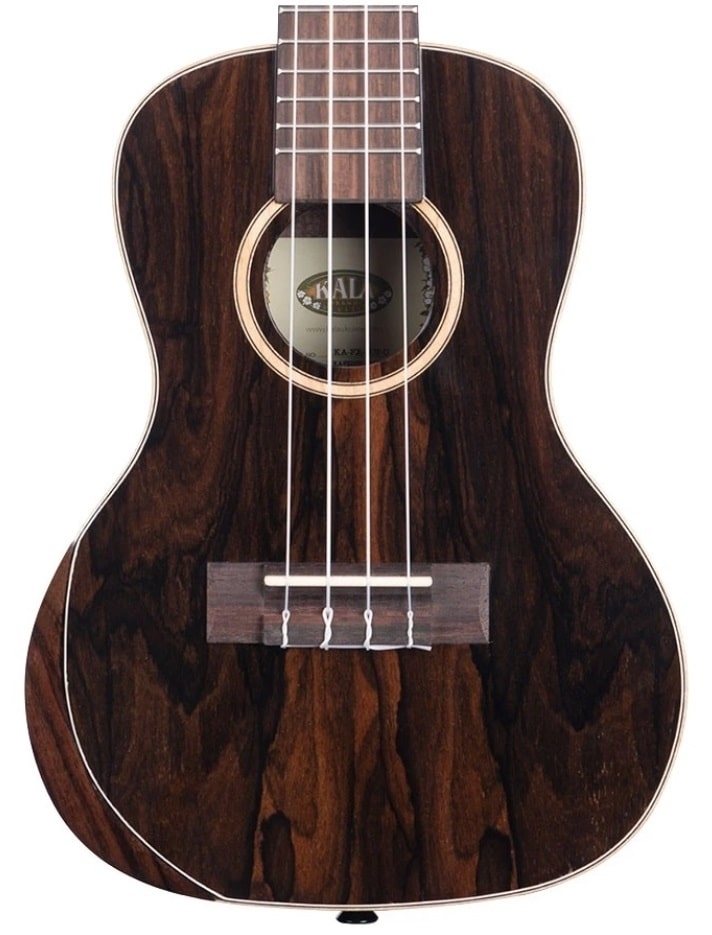 used for the back and sides and tops of ukuleles, but it is also sometimes used for acoustic guitars. Its appearance is very noticeable, as it has a dark brown colour with either a green or a purple undertone. The grain patterns are very striking and can vary widely. This makes ziricote a very unique and luxurious tonewood. The stunning aesthetic qualities of ziricote can be seen on the ukulele in the photo, which is the Kala KA-PX-ZCT-C, a popular ziricote ukulele. Consequently, ziricote is rarely painted over and thus mostly found with a clear lacquer to maintain the beautiful patterns. Furthermore, ziricote has amazing tonal qualities. It has a bright and articulate sound and is often compared to ebony. Ziricote also emphasises the high tones, which makes it especially popular for ukuleles. Other gorgeous ziricote ukuleles include the Leho LHUC-ZT and the Kala KA-ZCT-C. Ziricote is moreover quite sustainable. It is currently not classified as ‘vulnerable’ by the IUCN and CITES. If ziricote continues to be cultivated sustainably, it can continue to be a readily available and affordable tonewood for a long time to come!
used for the back and sides and tops of ukuleles, but it is also sometimes used for acoustic guitars. Its appearance is very noticeable, as it has a dark brown colour with either a green or a purple undertone. The grain patterns are very striking and can vary widely. This makes ziricote a very unique and luxurious tonewood. The stunning aesthetic qualities of ziricote can be seen on the ukulele in the photo, which is the Kala KA-PX-ZCT-C, a popular ziricote ukulele. Consequently, ziricote is rarely painted over and thus mostly found with a clear lacquer to maintain the beautiful patterns. Furthermore, ziricote has amazing tonal qualities. It has a bright and articulate sound and is often compared to ebony. Ziricote also emphasises the high tones, which makes it especially popular for ukuleles. Other gorgeous ziricote ukuleles include the Leho LHUC-ZT and the Kala KA-ZCT-C. Ziricote is moreover quite sustainable. It is currently not classified as ‘vulnerable’ by the IUCN and CITES. If ziricote continues to be cultivated sustainably, it can continue to be a readily available and affordable tonewood for a long time to come!
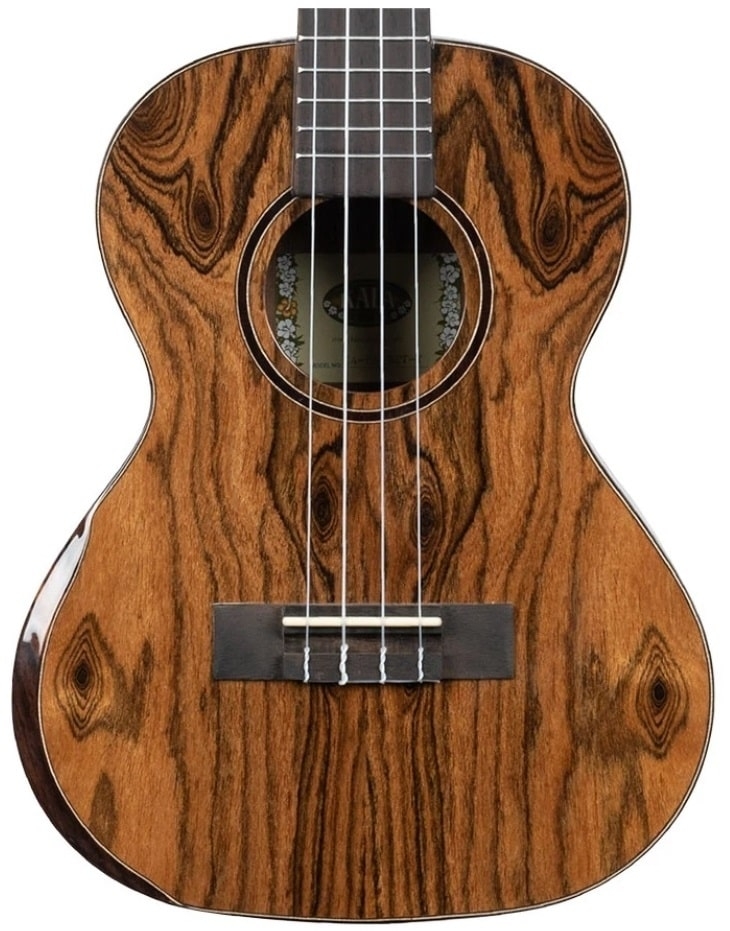
Bocote
Bocote originates from the same genera as ziricote, which means it’s also predominantly used for the back and sides and tops of ukuleles. They also look similar; bocote also has a dark brown colour and a remarkable grain pattern. Nevertheless, bocote is a slightly lighter shade of brown with a red undertone and darker grain. Bocote thus looks a little less dynamic than ziricote, although it still looks magnificent and unique. Subsequently, bocote is also rarely painted so its unique appearance will stand out. The beautiful ukulele on the photo is the Kala KA-PX-BCT-T. Bocote sounds a little warmer than ziricote, but is just as powerful. Unfortunately, it’s not very sustainable. The cordia alliodora, from which bocote is cultivated, is an invasive species in Middle America, which means it shouldn’t grow there and its presence thus harms the biodiversity of the forests. Consequently, the tree needs to be removed from the area. This has created the odd situation where deforestation is actually beneficial to the environment. Bocote is thus not unsustainable in the sense of consuming it, but in its presence. It’s also not listed by CITES or the IUCN. Bocote is thus a sustainable tonewood with amazing tonal qualities.
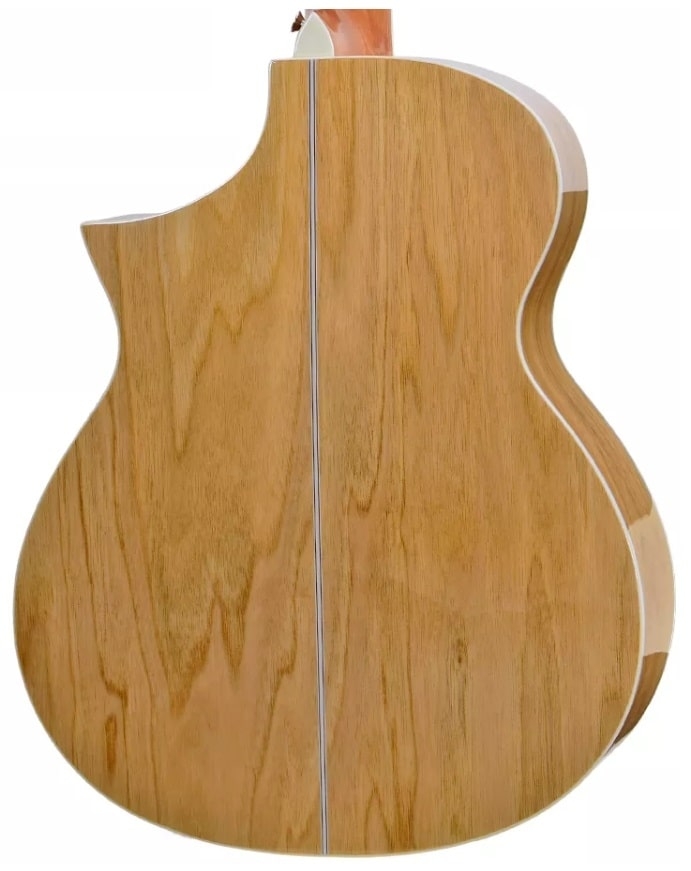
Catalpa
Catalpa is a tonewood that is predominantly used for hollow bodies and solid bodies. Catalpa is sourced from North America, the Caribbean, and East Asia. It has a light brown colour with a grey undertone. It’s relatively lightweight, like basswood, but it’s a little sturdier. Catalpa has amazing resonance and is thus mostly used for the back and sides of acoustic guitars, like with the Stagg SA35 DSCE-TB. It’s often compared to spruce, although spruce sounds and looks a little warmer. Fortunately, catalpa is relatively sustainable as well. It’s a common species which means it can be sourced from just about anywhere. It’s also not used all that often, which means the natural growth of the trees can sustain the cultivation. Catalpa is ideal for the environmentally friendly and versatile guitarist!
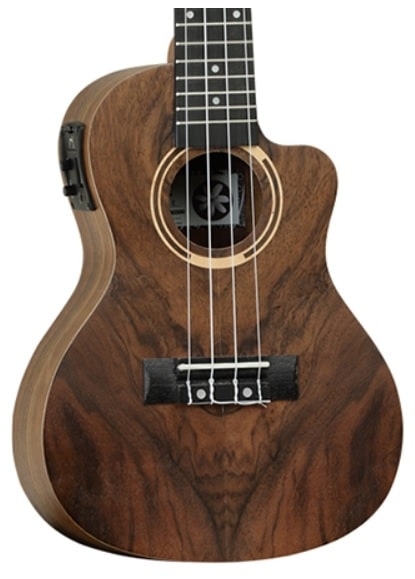
Rain Tree
Rain tree, which is actually called Samanea Saman, is a beautiful tonewood from Central and South America, but can now also be sourced from South Asia. It is predominantly used for the tops and back and sides of ukuleles, like the Tanglewood TWT21E and the Tanglewood TWT22E, although it can also be used for acoustic guitars. Rain tree has a beautiful and noticeable grain which will make your instrument appear luxurious and eye-catching. Furthermore, it also sounds amazing. Rain tree emphasises the bass tones without making them sound overwhelming as the high tones are still quite apparent. Rain tree thus produces a beautifully balanced sound, which makes it incredibly versatile. Fortunately, it’s also quite sustainable. Samanea Saman grows incredibly fast which means it isn’t a threatened species and can thus be sourced relatively sustainably.
Meranti
Meranti technically isn’t a singular tonewood 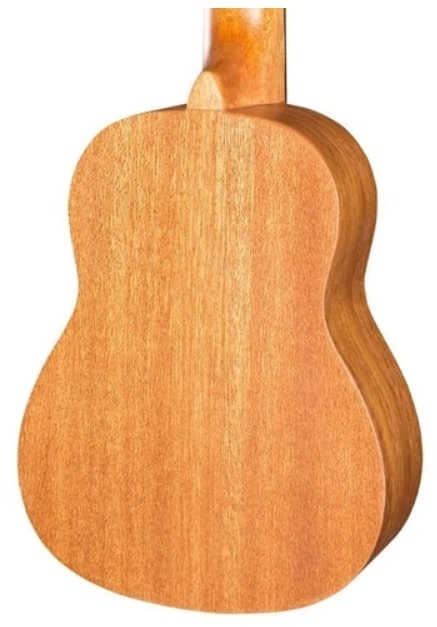 but consists of almost one hundred similar tree species from Southeast Asia. Meranti is predominantly used for tops, back and sides, and solid bodies. It’s quite rigid, which makes it ideal for hollow bodies as it won’t easily dent or break. It’s not a very eye-catching tonewood, though, as it has a light brown colour with either a grey or orange undertone and straight grain. Nevertheless, its neutral appearance does not negate the beautiful sound meranti produces. Meranti is known for its nicely balanced and consistent sound. It doesn’t specifically emphasise the lower or higher tones, nor does it sound overly bright or warm, but creates a nice balance between all of those. This makes meranti really versatile and is ideal for either someone who just started playing or guitarists who like to play many different types of genres. For example, the Yamaha C40 and the Yamaha C70 are amazing versatile classical guitars. Unfortunately, it’s not very sustainable. Although it grows quite quickly and has a high carbon sequestration rate, its growth cannot keep up with the incessant deforestation in Southeast Asia. Illegal lumber trade plays a significant role in this issue, as meranti can be farmed sustainably but a lot of the lumber that is exported to the West is unfortunately farmed illegally. This means there is a possibility that meranti guitars contribute to this deforestation, which depends on what suppliers guitar companies use.
but consists of almost one hundred similar tree species from Southeast Asia. Meranti is predominantly used for tops, back and sides, and solid bodies. It’s quite rigid, which makes it ideal for hollow bodies as it won’t easily dent or break. It’s not a very eye-catching tonewood, though, as it has a light brown colour with either a grey or orange undertone and straight grain. Nevertheless, its neutral appearance does not negate the beautiful sound meranti produces. Meranti is known for its nicely balanced and consistent sound. It doesn’t specifically emphasise the lower or higher tones, nor does it sound overly bright or warm, but creates a nice balance between all of those. This makes meranti really versatile and is ideal for either someone who just started playing or guitarists who like to play many different types of genres. For example, the Yamaha C40 and the Yamaha C70 are amazing versatile classical guitars. Unfortunately, it’s not very sustainable. Although it grows quite quickly and has a high carbon sequestration rate, its growth cannot keep up with the incessant deforestation in Southeast Asia. Illegal lumber trade plays a significant role in this issue, as meranti can be farmed sustainably but a lot of the lumber that is exported to the West is unfortunately farmed illegally. This means there is a possibility that meranti guitars contribute to this deforestation, which depends on what suppliers guitar companies use.
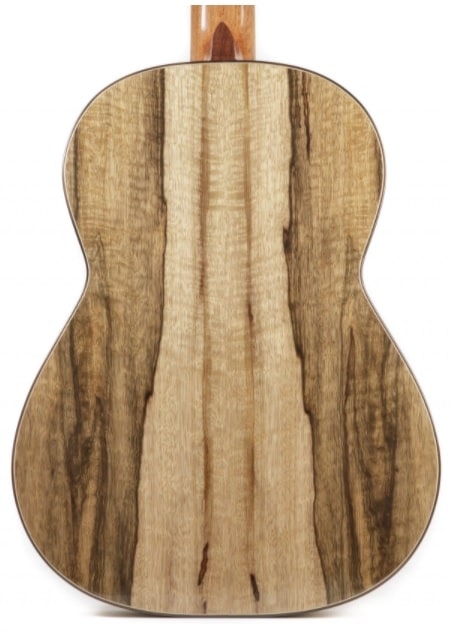
Limba
Limba is a versatile tonewood from West Africa. It’s a hardwood, which means it’s mostly used for solid-body electric guitars, like with the Michael Kelly 1950 Burl Burst, or the Michael Kelly Hybrid 55 Tiger’s Eye. Unfortunately, limba doesn’t have a very striking appearance. It has a yellow undertone and is relatively light. The appearance is just a small compromise, though, as limba has great resonance and a beautiful warm sound! Nowadays, it is also used as an alternative to mahogany. Additionally, its natural appearance is usually not visible, as most companies prefer to paint it, which means limba guitars can still look exquisite. It is moreover quite sustainable. Limba trees tend to be huge, which means only a few trees have to be cut down to sustain the lumber trade. It’s not on the CITES list, which confirms that it isn’t a threatened species.
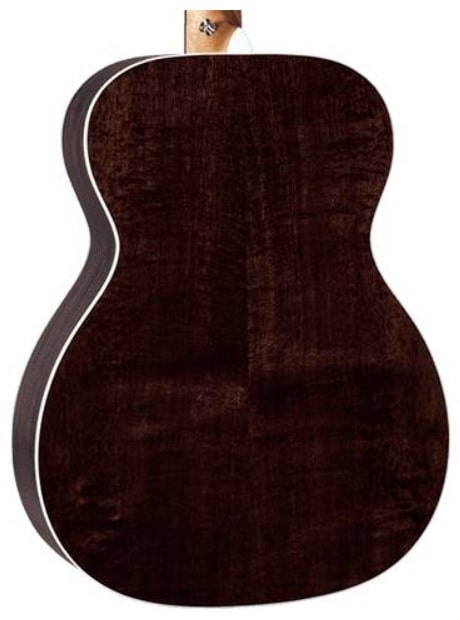
Siris
Sirs is a Central and South Asian tonewood that is most popularly used for the back and sides of acoustic guitars. It has a medium brown colour with a red undertone, quite similar to mahogany. Siris also has a beautiful warm sound with great resonance. Subsequently, siris is often used as an alternative to rosewood, as rosewood has become a threatened species. Martin, one of the oldest and best known acoustic guitar brands in the world, has also started using siris as a sustainable alternative, like with the Martin 000-13E. However, there are also guitarists who claim that siris is a good alternative for koa, instead. This is because both have a bright overtone and great projection. Siris is also quite sustainable. It’s not listed on the CITES list and the IUCN has classified it as ‘least concern'. This means it’s relatively environmentally friendly.
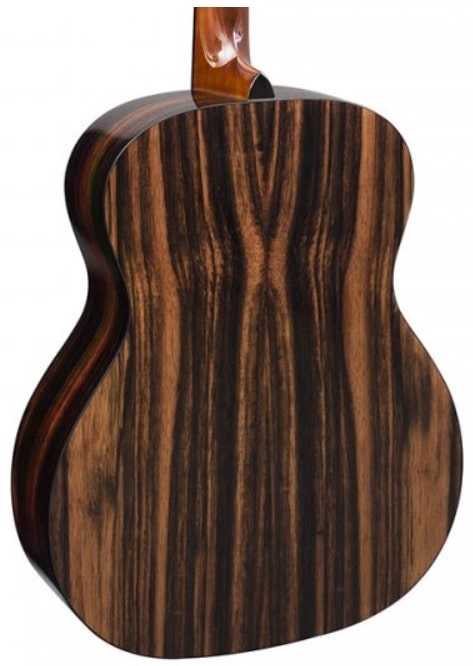
Amara
Amara, which is also known as Indian ebony, is a hardwood from India and Sri Lanka. It’s a beautiful tonewood as it has a dark brown colour and a striking grain pattern. The patterns can vary widely, which makes amara stand out from ebony. It also has a deep sound and a loud projection, which is the result of the high density of the wood. Amara is mostly used for the back and sides of western guitars, as is the case with the Tanglewood Exotic Java SFCE and the Tanglewood Exotic Java DS. Little is known about the sustainability of amara, but it’s not on the CITES list of threatened species.
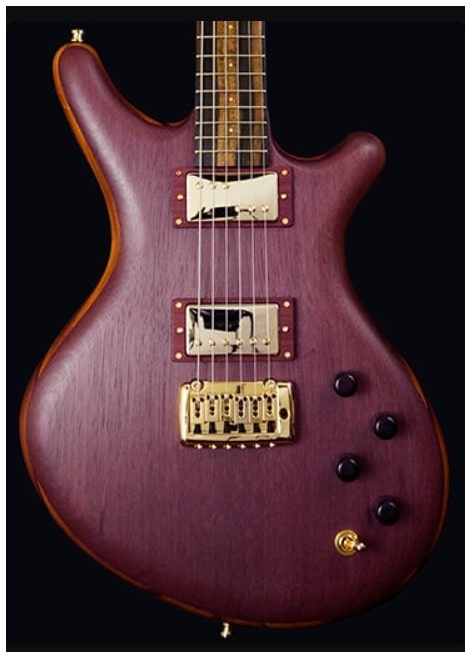
Purpleheart
Purpleheart, which is officially called peltogyne and sometimes also goes by amaranth, is a South-American tonewood. It is called purpleheart, as it has a purple-like undertone. When it’s cultivated, it will first look a little more grey, but over time in becomes more and more brown and purple. The grain is usually straight and not very noticeable. Purpleheart isn’t a commonly used wood in the guitar industry yet, but it’s popularity is increasing rapidly. It can be used for fretboards and back and sides of western guitars. Because it’s a relatively new material for guitars, its tonal qualities aren’t yet known. However, it’s incredibly rigid which means it will create a stable base for the body, or, most of all, it makes it a great wood to use for fretboards. Ibanez is one of the first companies to start using purpleheart. As such, they have electric guitars with purpleheart fretboards, like the Ibanez GSA60-BKN and the Ibanez GRG140-WH, and basses with purpleheart fretboards, like the Ibanez GSRM20B-WNF Mikro and the Ibanez GSR180-BS. Furthermore, it is also quite sustainable. It’s not listed by CITES or the IUCN. The trees also grow quite large which means a lot of lumber can be sourced from a single tree.
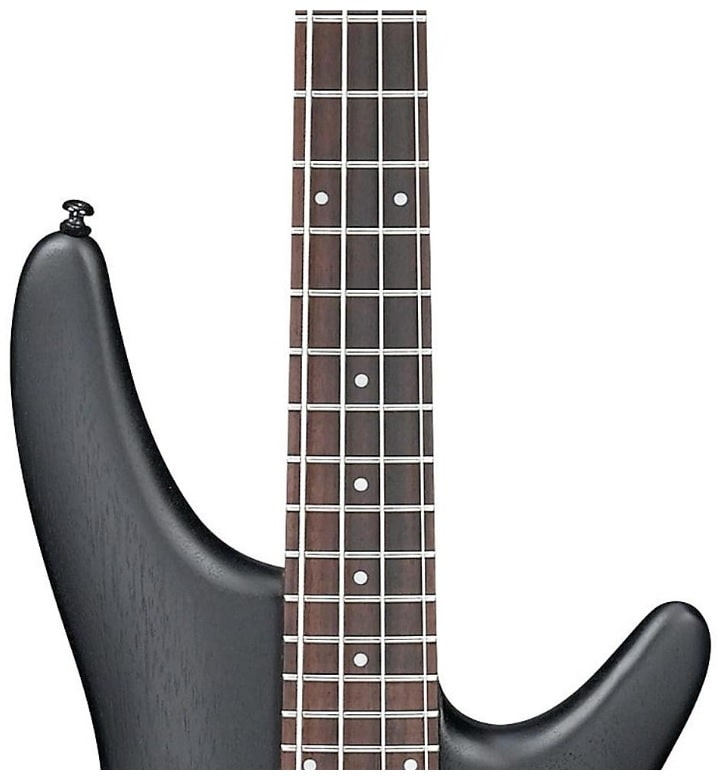
Jatoba
Jatoba is sourced from Middle and South America. It has a beautiful warm colour, usually medium brown with a red undertone. It’s will become a little darker through the years, which means it ages quite authentically. Jatoba is mostly used for fretboards, as it’s quite rigid and produces a warm sound. This also makes it a popular alternative for rosewood. Ibanez is one of the first larger companies to implement jatoba in their production process. They also mostly use it for fretboards, like with the Ibanez SR300EB, the Ibanez GSR200-BK, and the Ibanez GIO GRX40-BKN. Whether jatoba is sustainable, is hard to determine. The IUCN has classified it as ‘vulnerable’, but it’s not on the CITES list of threatened species. The general consensus is that jatoba isn’t very sustainable, although most of the lumber is cultivated under FSC guidelines which means jatoba guitars likely aren’t made with exploited materials.
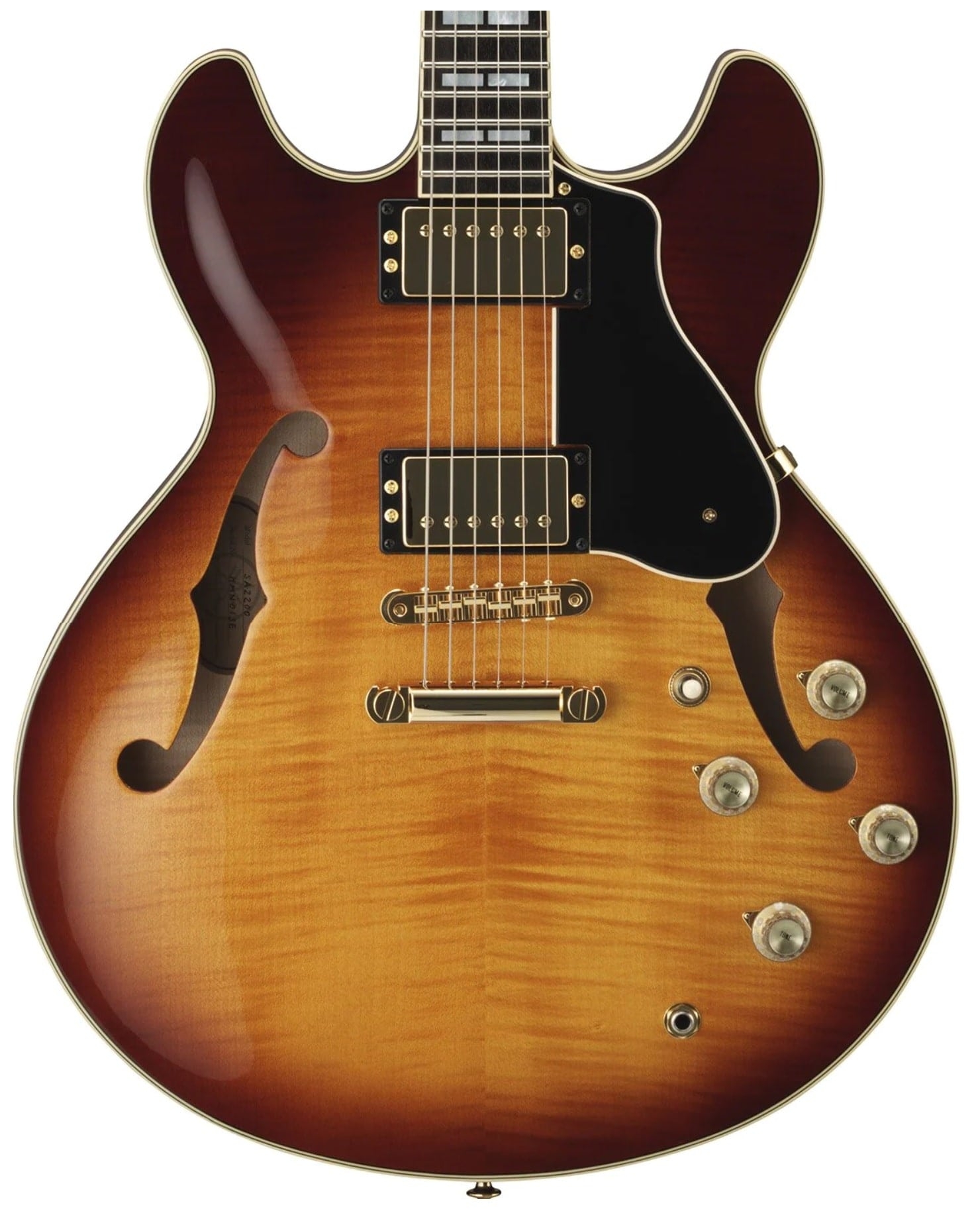
Sycamore
Sycamore is a North American tonewood that is predominantly used for solid body guitars, although it can also be used for hollow-body guitars, like with the Yamaha SA2200. Sycamore is often compared to maple as they produce a similar sound and appearance. Both have a beautiful light brown colour with a darker grain. Nevertheless, the structure resembles mahogany a bit more. Sycamore thus sounds like a great balance between maple and mahogany, as it has the same bright sound as maple and a similar projection as mahogany. Sycamore is quite soft, like basswood, which means it’s not ideal for guitarists who treat their instrument quite carelessly. Nevertheless, sycamore is stable enough for most guitarists as it still has to be hit quite hard for it to dent. Furthermore, it’s relatively sustainable as the trees grow quite fast and tall. Hence it’s not listed on the CITES list of threatened species or the IUCN Red List.
Synthetic materials
In all honesty, guitars don’t have to be made of wood. This article has shown that certain tonewoods are incredible for certain types of guitars or purposes, but there are also certain synthetic alternatives that are also of high quality. Guitars made of synthetic materials are still quite controversial; some guitarists find that guitars should remain as authentic as possible by constructing them with authentic tonewoods, whereas others find that the industry is ever developing and new innovative and more sustainable materials are to be expected and should be embraced. Subsequently, we find it important to include synthetic alternatives in this article as there is an increase in the question and the demand of guitars made with synthetic materials.
Bodies
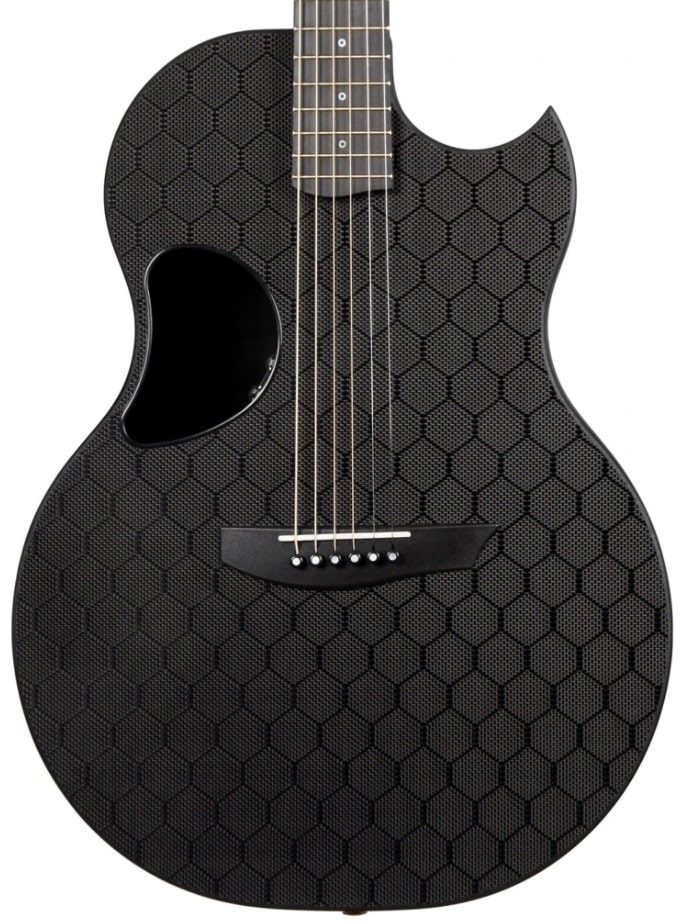
Let’s start with carbon fibre. Carbon fibre is made up of carbon atoms that are woven together. The fibres are about 5-10 micrometre in size (a micrometre is 0.001 millimetre), which means they are very small and many have to be stacked together to create a carbon fibre board. Carbon fibre guitars have many benefits, as they are very lightweight, they don't oxidise, they don't expand, they can withstand extreme temperatures, and they are very strong. The reason why wood is the standard in the guitar industry is because it has tonal properties. This is also why people tend to prefer guitars made of wood. What many people don’t know is that synthetic materials can also have tonal properties. Carbon fibre has powerful resonance and can produce different sounds depending on the shape and size of the guitar. Another reason why many people dislike carbon fibre, is because people are inclined to judge a book by its cover. Carbon fibre isn’t very aesthetically pleasing to most people. It usually has a black or grey colour with a fishnet-like pattern. Nevertheless, some people actually like this, as it’s very eye-catching and modern. Moreover, carbon fibre is quite reliable as it doesn’t require any maintenance and will not deteriorate or improve over time. Carbon fibre can also be produced relatively sustainably, although it cannot be recycled. Subsequently, carbon fibre products are only sustainable if they remain in use and aren’t discarded, as that will only increase the amount of non recyclable waste.
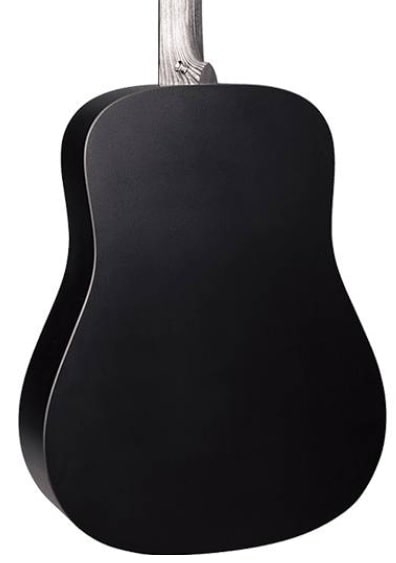
The next material, HPL, is commonly used for hollow bodies. HPL, which stands for High Pressure Laminate, is essentially also a type of wood, as it is made up of multiple wood fibre layers that have been pressed together with phenol-formaldehyde resin under a high temperature. This process results in an extremely sturdy and thin board. Furthermore, the resin seals the fibre, which means oxygen, sunlight, and moisture cannot reach the wood. Consequently, HPL does not require maintenance and the quality will not improve nor deteriorate through the years. It’s also extremely rigid, which means it can withstand a lot of abuse, and is thus also ideal for travel guitars. The disadvantage of this is that when HPL does break, it will be hard to fix. In the case of damage, a wooden guitar will develop a hole, whereas an HPL guitar will split. As HPL is made up of multiple layers, these layers will completely separate or even pulverise. A hole is relatively easy to fix, but this is unfortunately not the case with an HPL guitar, as a luthier would have to glue the individual pieces of every layer back together. However, reconstruction is not impossible, but it would have to be done by a professional and experienced luthier, and the reconstruction will always remain visible. Nevertheless, HPL rarely breaks, so you will likely not find yourself in this situation. Furthermore, HPL guitars are mostly debated for the sound. Purists tend to argue that an HPL guitar cannot sound as good as a wooden guitar, but there are also many guitarists who can admit that HPL produces a balanced and consistent sound. HPL is most often used for semi-acoustic guitars, because the consistency of HPL’s tone can be perfectly amplified. Moreover, it is also quite sustainable. Most woodfibres that make up HPL are made of recycled paper and wood. This means HPL is not a contributor to climate change or deforestation. The legendary Martin is one of the first large companies to start making HPL guitars on a large scale. Their X-Series, like the Martin D-X1E and the Martin D-X2E Koa. Martin thus also demonstrates the great tonal qualities of HPL, as their guitars are known for their beautiful and authentic tones.
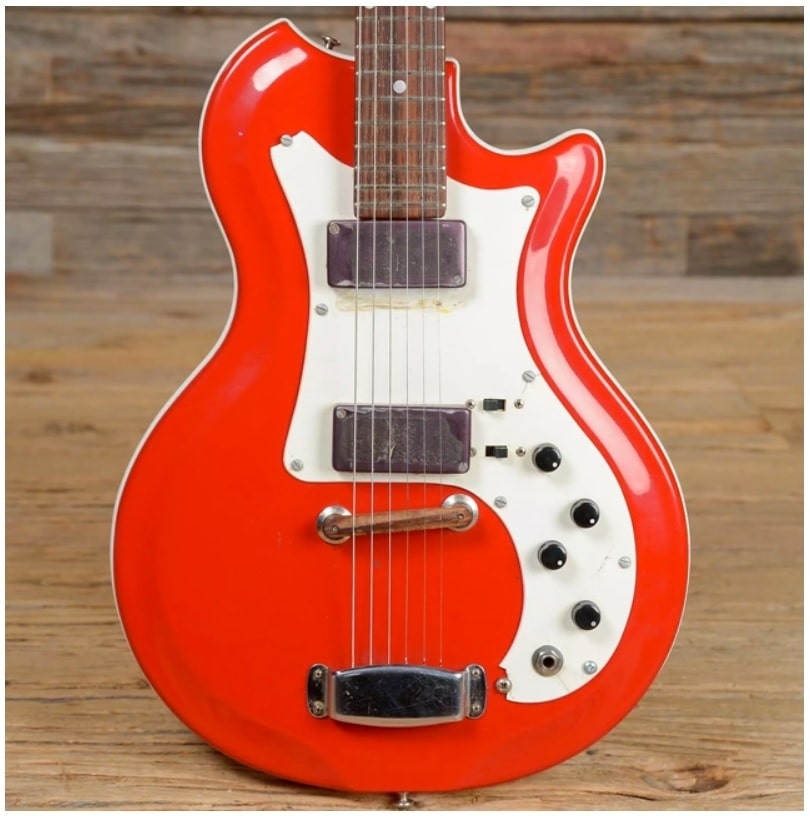
Another synthetic material is fibreglass. Fibreglass guitars are fairly old, which shows that synthetic guitars aren’t necessarily modern. The first fibreglass guitars hit the market in the ‘50s. Fibreglass is made up of glass fibres that are woven together with resin. Fibreglass is stronger than certain metals and cheaper and more flexible than carbon fibre. It’s not often used for guitars anymore, because carbon fibre produces better resonance and has better tonal qualities than fibreglass. However, fibreglass guitars are still available and due to its rigidity, it’s often used for guitar cases.
Polymethyl methacrylate, otherwise known as poly or acrylic glass, can 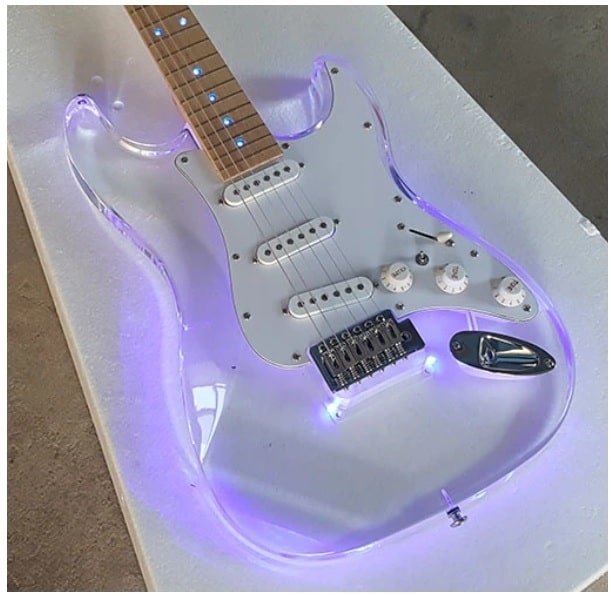 also be used for solid body guitars. Although it is sometimes called acrylic glass, it isn’t actually glass. Acrylic glass weighs less and is softer. The first poly guitar hit the market in the 1960s. The biggest advantage of poly is that it looks amazing. It’s transparent, which means it can look like glass, or colours or LED lights can be added. LED lights are very popular for these glass-like guitars, as they make the guitar look holographic, especially on a stage. Although poly guitars are still widely available, they are not produced by reputable guitar companies. This is because poly is not easy to work with and it does not have any tonal qualities. Consequently, the tone of the guitar solely depends on the pickups. The fact that poly doesn’t add anything to the sound is a dealbreaker for many companies. Poly guitars can still be found on the internet, but it’s often hard to figure out who is exactly producing these guitars, which means quality can differ a lot. Poly guitars are generally only recommended for guitarists who are willing to invest in a good looking guitar for on stage.
also be used for solid body guitars. Although it is sometimes called acrylic glass, it isn’t actually glass. Acrylic glass weighs less and is softer. The first poly guitar hit the market in the 1960s. The biggest advantage of poly is that it looks amazing. It’s transparent, which means it can look like glass, or colours or LED lights can be added. LED lights are very popular for these glass-like guitars, as they make the guitar look holographic, especially on a stage. Although poly guitars are still widely available, they are not produced by reputable guitar companies. This is because poly is not easy to work with and it does not have any tonal qualities. Consequently, the tone of the guitar solely depends on the pickups. The fact that poly doesn’t add anything to the sound is a dealbreaker for many companies. Poly guitars can still be found on the internet, but it’s often hard to figure out who is exactly producing these guitars, which means quality can differ a lot. Poly guitars are generally only recommended for guitarists who are willing to invest in a good looking guitar for on stage.
Fretboards
.jpg) Synthetic materials thrive when it comes to fretboards. There are only a few tonewoods that are rigid enough to be used for fretboards, and about half of them are threatened species. Subsequently, innovation was necessary. This resulted in Richlite. Richlite is made of recycled wood and paper fibres that are pressed together with resin. These sheets are then stacked and pressed, which results in a sturdy and balanced plank. Richlite is sustainable, which has been verified by organisations such as Greenguard, which verifies that the production process doesn’t produce harmful emissions, and the FSC, which make sure only sustainable materials were used. Richlite isn’t only sustainable, but it feels very authentic. It’s often compared to rosewood and ebony. This is good, because these two tonewoods are threatened yet very popular. Subsequently, more companies are using Richlite as an alternative, including Martin, Gibson, and Godin. Especially Martin and Gibson were known for their ebony fretboards, but they decided to invest in the environment and they switched to Richlite. Godin even claims that they also use Richlite because it’s simply superior to tonewoods. They argue that Richlite feels better and is easier to maintain. It’s also stronger than wood which means the guitars are more stable and have a longer lifespan. Furthermore, Richlite requires no maintenance. Tonewoods need to be cleaned and oiled every six months, but Richlite repels water and is very dense,
Synthetic materials thrive when it comes to fretboards. There are only a few tonewoods that are rigid enough to be used for fretboards, and about half of them are threatened species. Subsequently, innovation was necessary. This resulted in Richlite. Richlite is made of recycled wood and paper fibres that are pressed together with resin. These sheets are then stacked and pressed, which results in a sturdy and balanced plank. Richlite is sustainable, which has been verified by organisations such as Greenguard, which verifies that the production process doesn’t produce harmful emissions, and the FSC, which make sure only sustainable materials were used. Richlite isn’t only sustainable, but it feels very authentic. It’s often compared to rosewood and ebony. This is good, because these two tonewoods are threatened yet very popular. Subsequently, more companies are using Richlite as an alternative, including Martin, Gibson, and Godin. Especially Martin and Gibson were known for their ebony fretboards, but they decided to invest in the environment and they switched to Richlite. Godin even claims that they also use Richlite because it’s simply superior to tonewoods. They argue that Richlite feels better and is easier to maintain. It’s also stronger than wood which means the guitars are more stable and have a longer lifespan. Furthermore, Richlite requires no maintenance. Tonewoods need to be cleaned and oiled every six months, but Richlite repels water and is very dense,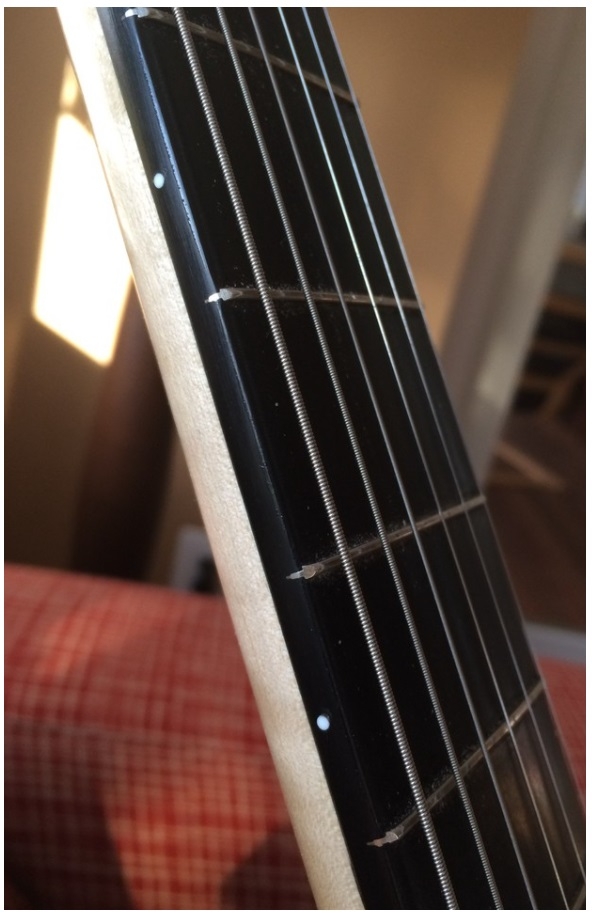 which means it cannot dehydrate or overhydrate. If there’s any dirt on the fretboard, you only need to wipe it off with a cloth. Richlite is relatively controversial, as is the case with all synthetic materials, although Richlite has become rather popular and is even used by professional and famous guitarists.
which means it cannot dehydrate or overhydrate. If there’s any dirt on the fretboard, you only need to wipe it off with a cloth. Richlite is relatively controversial, as is the case with all synthetic materials, although Richlite has become rather popular and is even used by professional and famous guitarists.
Rocklite is similar. Rocklite was developed as a response to the export ban of rosewood in 2017. It’s made to exactly replicate rosewood, both in colour and qualities. Rocklite is even more stable and sustainable. Nowadays they also produce an alternative for ebony: Rocklite Ebano. Just like the rosewood version, the material is more stable and sustainable than ebony. Furthermore, it won’t shrink or expand like authentic wood. Rocklite is made up of thin layers of wood that are pressed together with black resin at a high temperature. The production process is similar to Richlite; the difference is that Richlite contains different types of recycled materials, including paper, while Rocklite only uses certain hard wood types. The final product differs that Richlite is a sturdy material that is suited for wider use, whilst Rocklite is specifically meant to replicate rosewood or ebony. Moreover, Rocklite doesn’t require maintenance. Rocklite is still very new and not many big guitar brands use it yet. At the moment, it’s mostly used by individual luthiers.
Brownwood/blackwood is another innovative material for fretboards. This material is also produced 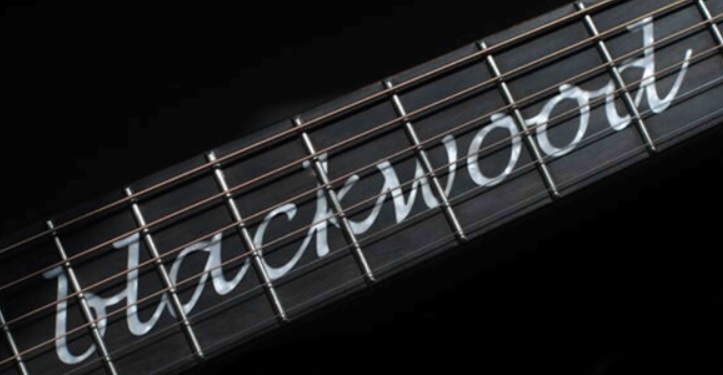 with real wood and thus isn’t completely synthetic. The wood is harvested from fast growing pine forests in New Zealand. These forests are easy to manage, which means the production of Brownwood/blackwood is accepted by the FSC. The pine wood will be dehydrated until there’s only ten percent moisture in the wood. Subsequently, it will be treated with a catalysator and dyes, after which it will be dried to three percent. The wood will then be pressed together with resin on a high temperature. As a result, the wood is very sturdy and has a high density, which means it’s rigid enough to be used for a fretboard. The wood is thus not only harvested sustainably, but the entire production process is environmentally friendly. No harmful substance or plastic is used. It’s also perfect for a fretboard, as it’s sturdy and stable and it requires no maintenance. The difference between blackwood and brownwood is the colour: blackwood is darker and is considered an alternative for ebony, whereas brownwood is a little lighter and is a great alternative for rosewood. A company that uses this material often is Lâg, but it’s also increasingly used by James Neligan and Stagg. For example, it is used with the Lâg T118ASCE and the James Neligan BES-A-DCB.
with real wood and thus isn’t completely synthetic. The wood is harvested from fast growing pine forests in New Zealand. These forests are easy to manage, which means the production of Brownwood/blackwood is accepted by the FSC. The pine wood will be dehydrated until there’s only ten percent moisture in the wood. Subsequently, it will be treated with a catalysator and dyes, after which it will be dried to three percent. The wood will then be pressed together with resin on a high temperature. As a result, the wood is very sturdy and has a high density, which means it’s rigid enough to be used for a fretboard. The wood is thus not only harvested sustainably, but the entire production process is environmentally friendly. No harmful substance or plastic is used. It’s also perfect for a fretboard, as it’s sturdy and stable and it requires no maintenance. The difference between blackwood and brownwood is the colour: blackwood is darker and is considered an alternative for ebony, whereas brownwood is a little lighter and is a great alternative for rosewood. A company that uses this material often is Lâg, but it’s also increasingly used by James Neligan and Stagg. For example, it is used with the Lâg T118ASCE and the James Neligan BES-A-DCB.
The next option is eboncore. It’s a little like Richlite and is specifically developed as an alternative for ebony. It’s an environmentally friendly material and feels exactly like ebony. Moreover, it’s sturdier than ebony which means the neck is more stable and the guitar has a better and more consistent intonation. It’s also more sustainable than ebony and is accepted by CITES. The only company that uses it is Tanglewood. They claim that eboncore is more comfortable and stable than ebony.
There are thus a couple of different synthetic possibilities. All materials have several pros and cons and sound qualities. For bodies carbon fibre and HPL are proper and popular materials that are even used for professional guitars. When it comes to fretboards we find that there are increasingly more alternatives for rosewood and ebony. These alternatives are partially made of wood and resin, which means they have all the pros of wood and synthetic materials. As discussed before, synthetic materials remain a point of discussion, but the pros cannot be ignored. Synthetic materials remove all cons of wood. This is because wood is ‘alive’, which means it’s a porous material and is thus dependent on the atmosphere and climate. Wood needs to be maintained to prevent dehydration or overhydration. As such, the quality of wood isn’t consistent. Synthetic materials are not porous and cannot be affected, and is thus consistent. These materials cannot expand, shrink, bend, change in sound, or require maintenance. Consequently, a fretboard made of Richlite is a great option for guitarists who require a reliable and easy fretboard, or carbon fibre is the ideal choice for guitarists who require sustainability. Furthermore, synthetic materials aren’t necessarily bad sound materials. Nowadays, these materials have been developed to blend in with the sound qualities of real tonewood. The quality of the instrument is also dependent on the individual instrument, of course. There are bad guitars that are made of the best tonewoods, just like there are bad guitars made of great synthetic materials. As such, it’s important to experience the instrument yourself. The decision between synthetic or wood remains one that the individual consumer should make themselves.
What now?
There are thus many different tonewoods and materials that can be used for a guitar. They all contain unique qualities which may make the choice hard. The most important aspect of choosing a guitar remains feel and sound, which you can figure out by trying out different guitars. Sometimes it turns out that certain woods one may have doubts about are actually really good. As such, we advise to not make exceptions based on the opinion of others wit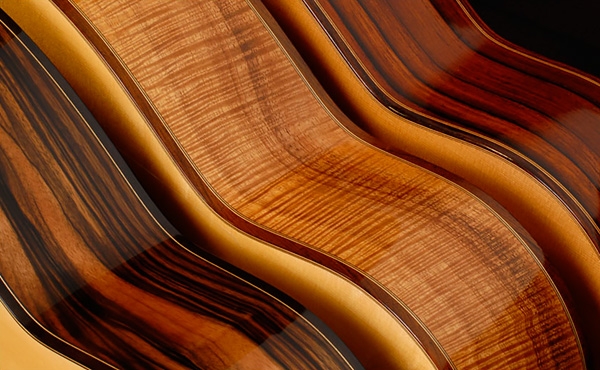 hout trying them out. This article is meant to solely give you an idea of what the qualities of certain tonewoods are, what the effect on the environment is, and what the possible alternatives are. This article also explains why alternatives may be necessary and why companies may not use certain tonewoods, even if they were known to use these woods before. Which tonewood is the best depends on the individual guitarist. This is a discussion that has been ongoing for over a century, and there still isn’t a consensus. Subsequently, it’s important for individual consumers to make up your own mind. Unfortunately, it’s inevitable that certain tonewoods on this list will be unavailable in a couple of years; due to climate change or deforestation, but also due to natural circumstances or restrictions. However, as a result of this new tonewoods will be added. By nature, humanity is constantly searching for solutions and possibilities, and it’s only a matter of time before new tonewoods will be discovered or new synthetic materials will be invented.
hout trying them out. This article is meant to solely give you an idea of what the qualities of certain tonewoods are, what the effect on the environment is, and what the possible alternatives are. This article also explains why alternatives may be necessary and why companies may not use certain tonewoods, even if they were known to use these woods before. Which tonewood is the best depends on the individual guitarist. This is a discussion that has been ongoing for over a century, and there still isn’t a consensus. Subsequently, it’s important for individual consumers to make up your own mind. Unfortunately, it’s inevitable that certain tonewoods on this list will be unavailable in a couple of years; due to climate change or deforestation, but also due to natural circumstances or restrictions. However, as a result of this new tonewoods will be added. By nature, humanity is constantly searching for solutions and possibilities, and it’s only a matter of time before new tonewoods will be discovered or new synthetic materials will be invented.
There will thus always be a wide array of choices. It’s up to you to decide which aspects you prioritise. Guitarists who prioritise authenticity often disregard sustainability. However, there are also guitarists who prioritise sustainability over authenticity. These alternatives are also often appreciated. Someone who loves rosewood is often satisfied with pau ferro or Indian laurel. Some disregard both authenticity and sustainability and focus on the sound qualities of the materials, or some just focus on the price. There is no superior method, it’s your decision. Regardless of your priorities, there is a compact list of possible alternatives down below. As such, it’s up to us as a music store to enthusiastically help you find an instrument that lives up to all of your expectations.
Possible alternatives
There are many reasons as to why you might not want to buy certain woods, whilst simultaneously wanting a certain appearance or sound. Reasons might include the price or the rarity of a tonewood, that a brand you like might not use certain woods, that the woods you want don’t complement each other, or that you want an environmentally friendly guitar. There are thus many situations where an alternative tonewood would be a better option. As such, we have compiled a compact list that compares the different tonewoods. Due to the brevity of the list, nuances between the woods aren’t explained in depth. Furthermore, it’s good to have realistic expectations; alternatives are never 100% replicas. A tonewood with a similar sound can have a completely different appearance or feel, or a fretboard can have the same feel but may be drier. We have attempted to explain these differences briefly in the list down below. For more information or help you can contact us or visit the store.
Cedar: redwood (alternative for sound; redwood sounds a little brighter), spruce (alternative appearance-wise, not for sound)
Mahogany: khaya (alternative for sound; khaya sounds a little brighter), sapele (for back and sides; sapele sounds a little sharper and is cheaper), nato (sounds a little sharper), okoume (similar sound with acoustic guitars), limba (more sustainable, sounds similar but looks very different), sycamore (alternative for sound, sounds a little brighter), siris (alternative for appearance and sound, but sounds a little warmer)
Rosewood: ovangkol (alternative for back and sides; ovangkal sounds a little brighter), Indian laurel (for fretboards, laurel is a little drier, lighter, and more sustainable), pau ferro (for fretboards, pau ferro has a lighter colour and is more sustainable), jatoba (alternative for fretboards), Richlite (synthetic fretboard, similar feel but has a darker appearance and is water-resistant), Rocklite (almost perfect alternative to rosewood, Rocklite is a little sturdier and more sustainable), brownwood (more sustainable and sturdier)
Redwood: cedar (alternative for sound, sounds a little warmer and is more sustainable than redwood)
Ebony: macassar (both for fretboards and back and sides, a little more sustainable), pau ferro (for fretboards, similar feel but a different colour and more sustainable), Richlite (synthetic fretboard, similar feel but more sustainable), eboncore (alternative for fretboards, more stabile and sustainable), Rocklite (almost perfect alternative for ebony, Rocklite is a little sturdier and more sustainable), blackwood (more sustainable and sturdier)
Maple: okoume (alternative for hollow bodies, maple sounds a little warmer and is more sustainable than okoume), spruce (for appearance, not for sound)
Alder: poplar (for solid-body guitars, poplar is a little softer and has less sustain), ash (ash is a little heavier and is less sustainable than alder)
Poplar: alder (for solid-body guitars, alder is a little harder and has more sustain), basswood (basswood is a little softer and is cheaper than poplar), nyatoh (for solid-body guitars, nyatoh is a little heavier)
Ash: alder (alder is a little softer, more sustainable, and lighter), pine (similar density and resonance, pine is a little heavier and more sustainable), sungkai (is known as Indonesian ash, similar sound and appearance)
Koa: walnut (has a similar bright sound, although walnut sounds deeper and is more sustainable)
Okoume: maple (alternative for sound, maple has a better projection and is more sustainable)
Spruce: catalpa (sounds a little less warm and has a more grey colour than spruce)

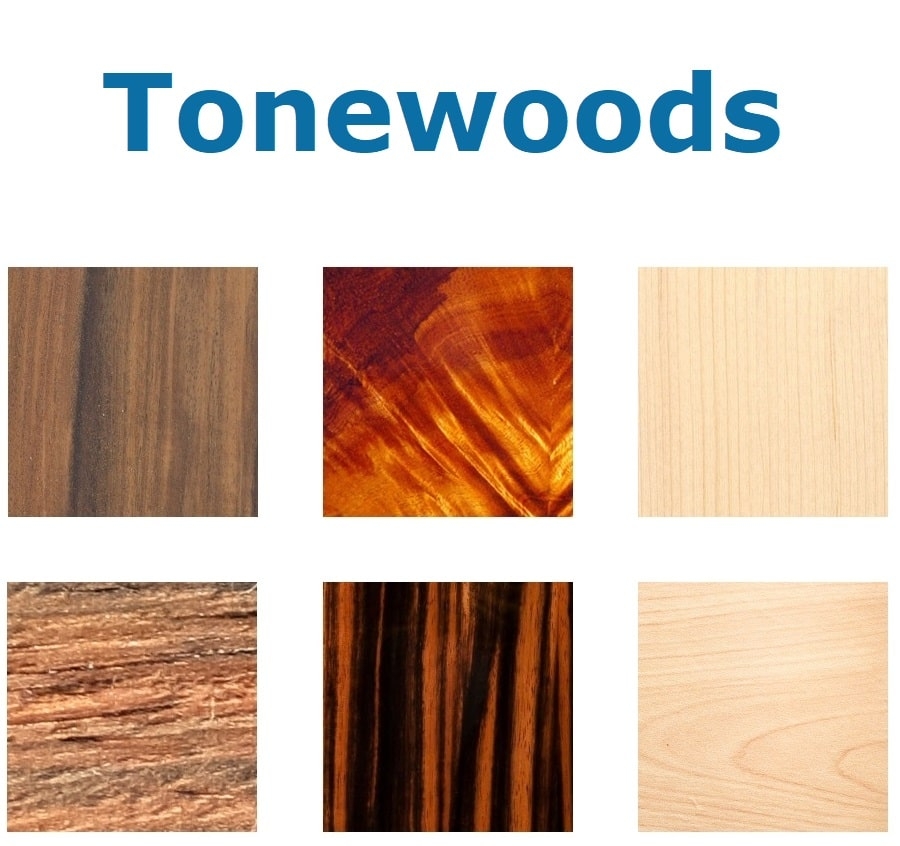





 a result, Brazil has implemented an export ban, which is why Indian rosewood is predominantly used nowadays. However, Indian rosewood is also quite exploited, unfortunately. Indian rosewood has a dark purple hue and feels rougher than Brazilian rosewood, but both have similar tone qualities. Rosewood is considered a very authentic tonewood, but due to deforestation, it is unfortunately not sustainable. Rosewood is still used sometimes, but the lumber industry doesn’t prioritise the guitar industry. Most of the rosewood that is available, is bought by the larger guitar companies, which is why rosewood is often only used by certain brands on more expensive guitars. This also means that rosewood isn’t really an option for guitarists with a lower budget, as it is quite expensive. However, there are great alternatives, like pau ferro or ovangkol. A more extensive summary of alternatives can be found at the end of the article!
a result, Brazil has implemented an export ban, which is why Indian rosewood is predominantly used nowadays. However, Indian rosewood is also quite exploited, unfortunately. Indian rosewood has a dark purple hue and feels rougher than Brazilian rosewood, but both have similar tone qualities. Rosewood is considered a very authentic tonewood, but due to deforestation, it is unfortunately not sustainable. Rosewood is still used sometimes, but the lumber industry doesn’t prioritise the guitar industry. Most of the rosewood that is available, is bought by the larger guitar companies, which is why rosewood is often only used by certain brands on more expensive guitars. This also means that rosewood isn’t really an option for guitarists with a lower budget, as it is quite expensive. However, there are great alternatives, like pau ferro or ovangkol. A more extensive summary of alternatives can be found at the end of the article!

 it can also be used for hollow-body guitars. An ebony fretboard will balance out the sound beautifully, which makes it a popular choice. Great guitars with ebony fretboards are the
it can also be used for hollow-body guitars. An ebony fretboard will balance out the sound beautifully, which makes it a popular choice. Great guitars with ebony fretboards are the 






 different climates. It has little resonance, which means it’s not ideal for hollow bodies. This means it’s mostly used for
different climates. It has little resonance, which means it’s not ideal for hollow bodies. This means it’s mostly used for 


 tonewood. It isn’t rare like mahogany, which is rare due to deforestation, but rare because it simply isn’t used that often. It’s most often used as a
tonewood. It isn’t rare like mahogany, which is rare due to deforestation, but rare because it simply isn’t used that often. It’s most often used as a 
-min.jpg)



 used for the
used for the 


 but consists of almost one hundred similar tree species from Southeast Asia. Meranti is predominantly used for tops,
but consists of almost one hundred similar tree species from Southeast Asia. Meranti is predominantly used for tops, 








 also be used for solid body guitars. Although it is sometimes called acrylic glass, it isn’t actually glass. Acrylic glass weighs less and is softer. The first poly guitar hit the market in the 1960s. The biggest advantage of poly is that it looks amazing. It’s transparent, which means it can look like glass, or colours or LED lights can be added. LED lights are very popular for these glass-like guitars, as they make the guitar look holographic, especially on a stage. Although poly guitars are still widely available, they are not produced by reputable guitar companies. This is because poly is not easy to work with and it does not have any tonal qualities. Consequently, the tone of the guitar solely depends on the pickups. The fact that poly doesn’t add anything to the sound is a dealbreaker for many companies. Poly guitars can still be found on the internet, but it’s often hard to figure out who is exactly producing these guitars, which means quality can differ a lot. Poly guitars are generally only recommended for guitarists who are willing to invest in a good looking guitar for on stage.
also be used for solid body guitars. Although it is sometimes called acrylic glass, it isn’t actually glass. Acrylic glass weighs less and is softer. The first poly guitar hit the market in the 1960s. The biggest advantage of poly is that it looks amazing. It’s transparent, which means it can look like glass, or colours or LED lights can be added. LED lights are very popular for these glass-like guitars, as they make the guitar look holographic, especially on a stage. Although poly guitars are still widely available, they are not produced by reputable guitar companies. This is because poly is not easy to work with and it does not have any tonal qualities. Consequently, the tone of the guitar solely depends on the pickups. The fact that poly doesn’t add anything to the sound is a dealbreaker for many companies. Poly guitars can still be found on the internet, but it’s often hard to figure out who is exactly producing these guitars, which means quality can differ a lot. Poly guitars are generally only recommended for guitarists who are willing to invest in a good looking guitar for on stage..jpg) Synthetic materials thrive when it comes to fretboards. There are only a few tonewoods that are rigid enough to be used for fretboards, and about half of them are threatened species. Subsequently, innovation was necessary. This resulted in Richlite. Richlite is made of recycled wood and paper fibres that are pressed together with resin. These sheets are then stacked and pressed, which results in a sturdy and balanced plank. Richlite is sustainable, which has been verified by organisations such as Greenguard, which verifies that the production process doesn’t produce harmful emissions, and the FSC, which make sure only sustainable materials were used. Richlite isn’t only sustainable, but it feels very authentic. It’s often compared to rosewood and ebony. This is good, because these two tonewoods are threatened yet very popular. Subsequently, more companies are using Richlite as an alternative, including Martin, Gibson, and Godin. Especially Martin and Gibson were known for their ebony fretboards, but they decided to invest in the environment and they switched to Richlite. Godin even claims that they also use Richlite because it’s simply superior to tonewoods. They argue that Richlite feels better and is easier to maintain. It’s also stronger than wood which means the guitars are more stable and have a longer lifespan. Furthermore, Richlite requires no maintenance. Tonewoods need to be cleaned and oiled every six months, but Richlite repels water and is very dense,
Synthetic materials thrive when it comes to fretboards. There are only a few tonewoods that are rigid enough to be used for fretboards, and about half of them are threatened species. Subsequently, innovation was necessary. This resulted in Richlite. Richlite is made of recycled wood and paper fibres that are pressed together with resin. These sheets are then stacked and pressed, which results in a sturdy and balanced plank. Richlite is sustainable, which has been verified by organisations such as Greenguard, which verifies that the production process doesn’t produce harmful emissions, and the FSC, which make sure only sustainable materials were used. Richlite isn’t only sustainable, but it feels very authentic. It’s often compared to rosewood and ebony. This is good, because these two tonewoods are threatened yet very popular. Subsequently, more companies are using Richlite as an alternative, including Martin, Gibson, and Godin. Especially Martin and Gibson were known for their ebony fretboards, but they decided to invest in the environment and they switched to Richlite. Godin even claims that they also use Richlite because it’s simply superior to tonewoods. They argue that Richlite feels better and is easier to maintain. It’s also stronger than wood which means the guitars are more stable and have a longer lifespan. Furthermore, Richlite requires no maintenance. Tonewoods need to be cleaned and oiled every six months, but Richlite repels water and is very dense, which means it cannot dehydrate or overhydrate. If there’s any dirt on the fretboard, you only need to wipe it off with a cloth. Richlite is relatively controversial, as is the case with all synthetic materials, although Richlite has become rather popular and is even used by professional and famous guitarists.
which means it cannot dehydrate or overhydrate. If there’s any dirt on the fretboard, you only need to wipe it off with a cloth. Richlite is relatively controversial, as is the case with all synthetic materials, although Richlite has become rather popular and is even used by professional and famous guitarists. with real wood and thus isn’t completely synthetic. The wood is harvested from fast growing pine forests in New Zealand. These forests are easy to manage, which means the production of Brownwood/blackwood is accepted by the FSC. The pine wood will be dehydrated until there’s only ten percent moisture in the wood. Subsequently, it will be treated with a catalysator and dyes, after which it will be dried to three percent. The wood will then be pressed together with resin on a high temperature. As a result, the wood is very sturdy and has a high density, which means it’s rigid enough to be used for a fretboard. The wood is thus not only harvested sustainably, but the entire production process is environmentally friendly. No harmful substance or plastic is used. It’s also perfect for a fretboard, as it’s sturdy and stable and it requires no maintenance. The difference between blackwood and brownwood is the colour: blackwood is darker and is considered an alternative for ebony, whereas brownwood is a little lighter and is a great alternative for rosewood. A company that uses this material often is
with real wood and thus isn’t completely synthetic. The wood is harvested from fast growing pine forests in New Zealand. These forests are easy to manage, which means the production of Brownwood/blackwood is accepted by the FSC. The pine wood will be dehydrated until there’s only ten percent moisture in the wood. Subsequently, it will be treated with a catalysator and dyes, after which it will be dried to three percent. The wood will then be pressed together with resin on a high temperature. As a result, the wood is very sturdy and has a high density, which means it’s rigid enough to be used for a fretboard. The wood is thus not only harvested sustainably, but the entire production process is environmentally friendly. No harmful substance or plastic is used. It’s also perfect for a fretboard, as it’s sturdy and stable and it requires no maintenance. The difference between blackwood and brownwood is the colour: blackwood is darker and is considered an alternative for ebony, whereas brownwood is a little lighter and is a great alternative for rosewood. A company that uses this material often is  hout trying them out. This article is meant to solely give you an idea of what the qualities of certain tonewoods are, what the effect on the environment is, and what the possible alternatives are. This article also explains why alternatives may be necessary and why companies may not use certain tonewoods, even if they were known to use these woods before. Which tonewood is the best depends on the individual guitarist. This is a discussion that has been ongoing for over a century, and there still isn’t a consensus. Subsequently, it’s important for individual consumers to make up your own mind. Unfortunately, it’s inevitable that certain tonewoods on this list will be unavailable in a couple of years; due to climate change or deforestation, but also due to natural circumstances or restrictions. However, as a result of this new tonewoods will be added. By nature, humanity is constantly searching for solutions and possibilities, and it’s only a matter of time before new tonewoods will be discovered or new synthetic materials will be invented.
hout trying them out. This article is meant to solely give you an idea of what the qualities of certain tonewoods are, what the effect on the environment is, and what the possible alternatives are. This article also explains why alternatives may be necessary and why companies may not use certain tonewoods, even if they were known to use these woods before. Which tonewood is the best depends on the individual guitarist. This is a discussion that has been ongoing for over a century, and there still isn’t a consensus. Subsequently, it’s important for individual consumers to make up your own mind. Unfortunately, it’s inevitable that certain tonewoods on this list will be unavailable in a couple of years; due to climate change or deforestation, but also due to natural circumstances or restrictions. However, as a result of this new tonewoods will be added. By nature, humanity is constantly searching for solutions and possibilities, and it’s only a matter of time before new tonewoods will be discovered or new synthetic materials will be invented.
.jpg)
